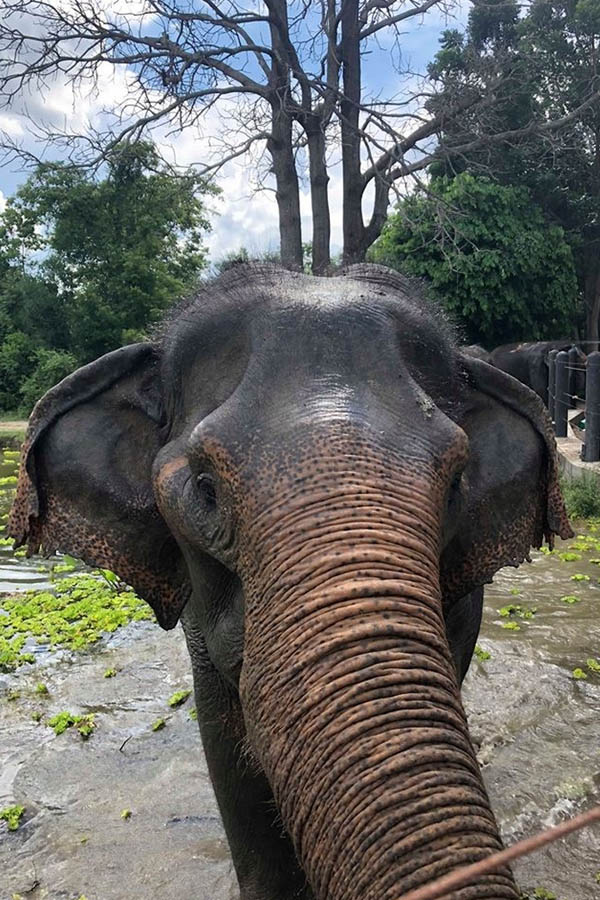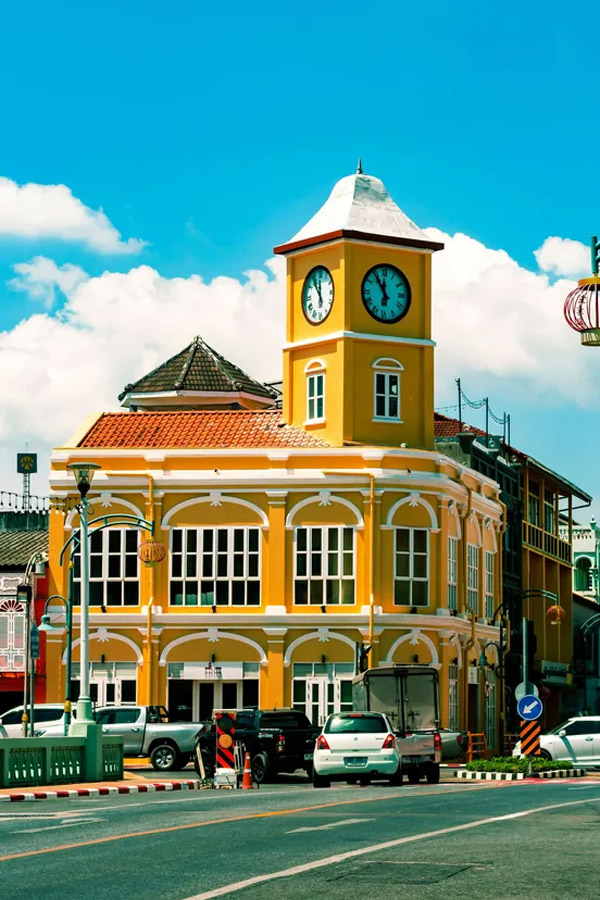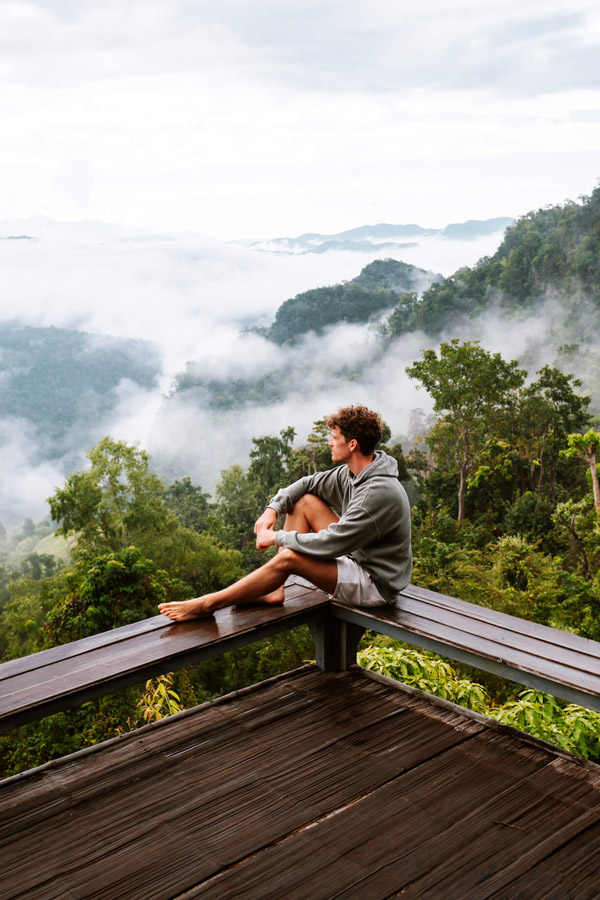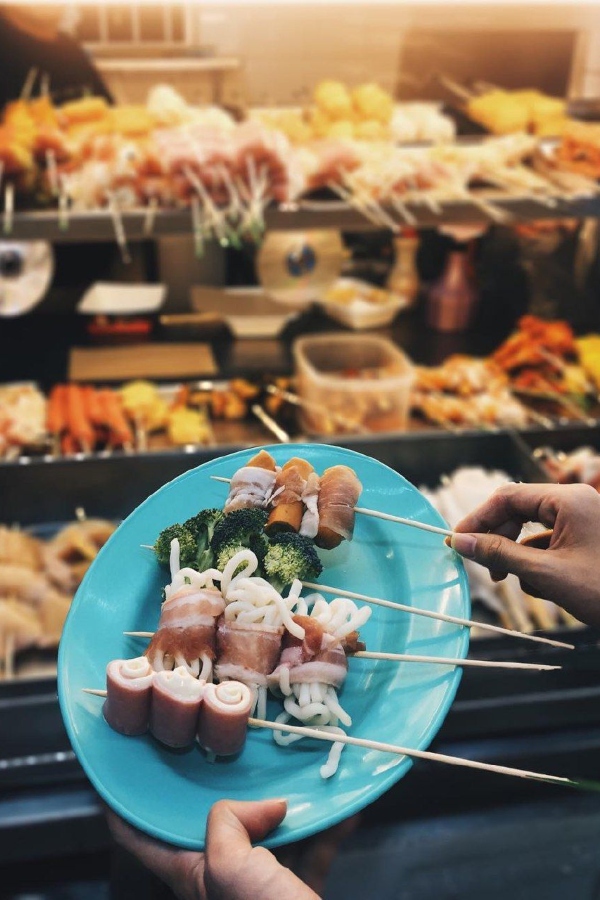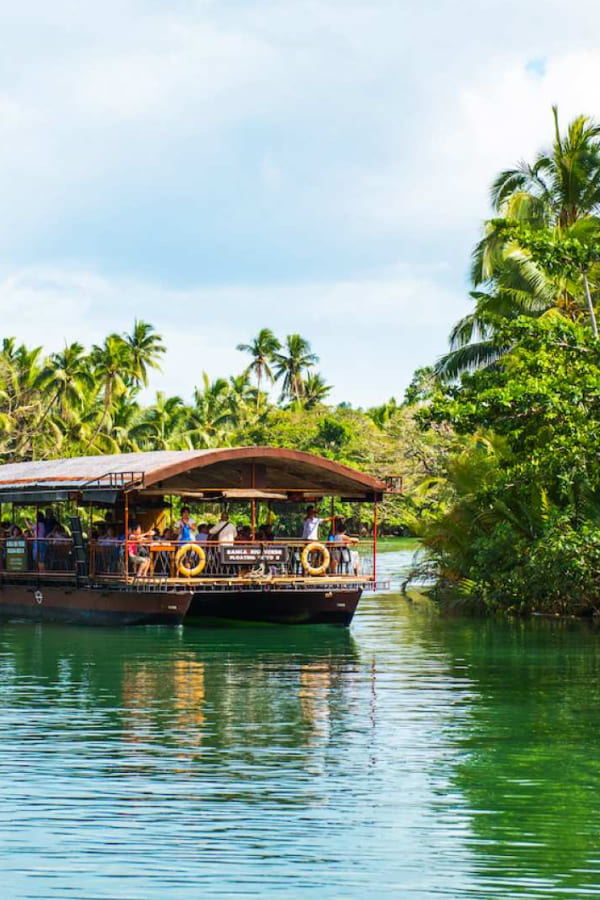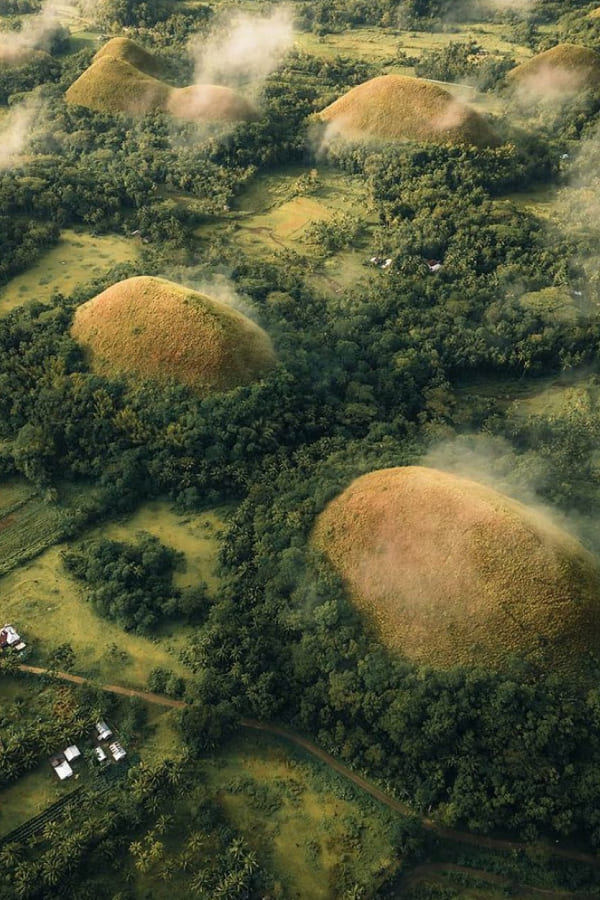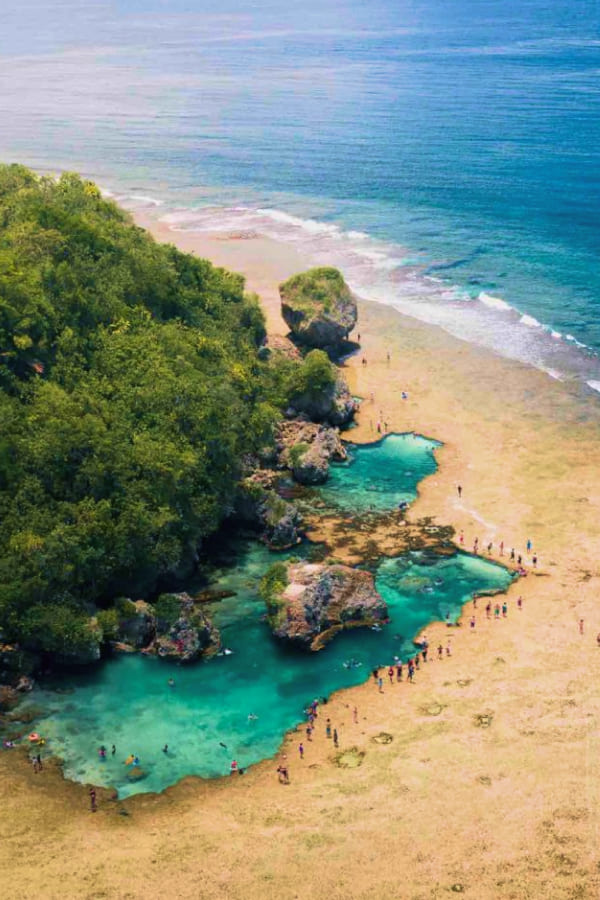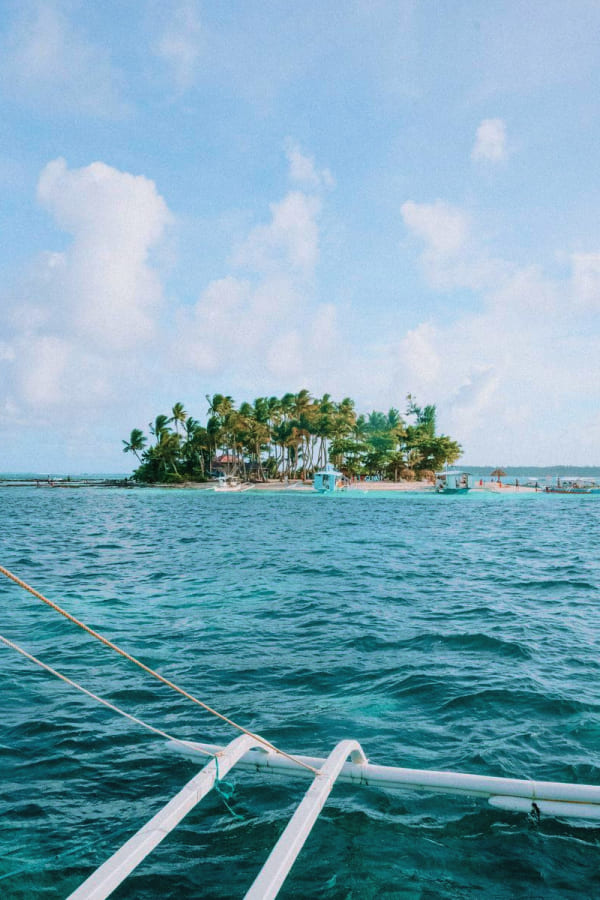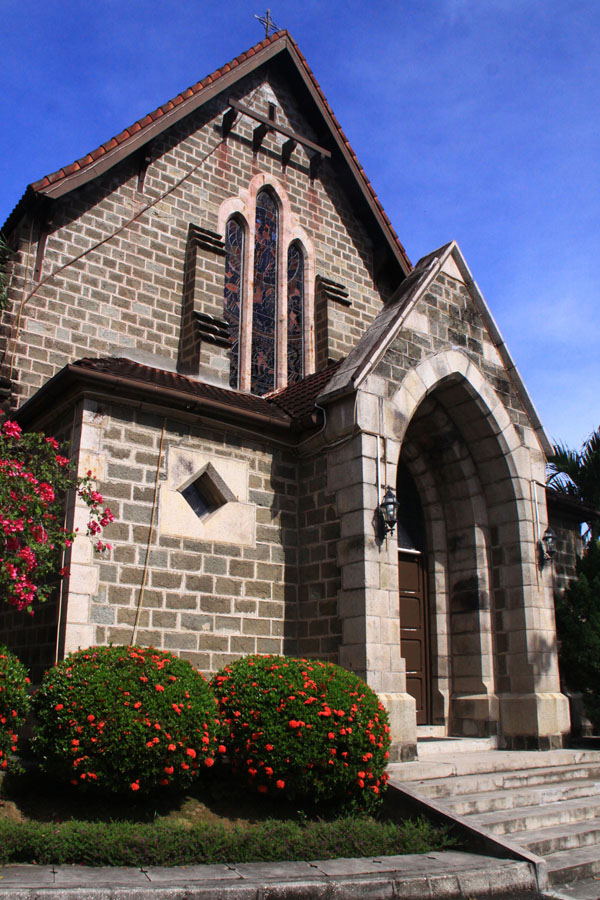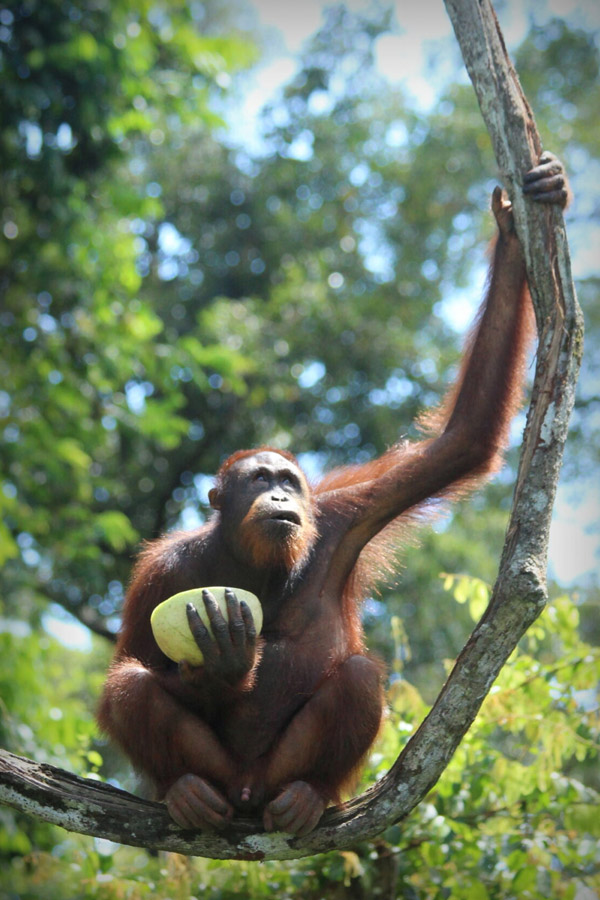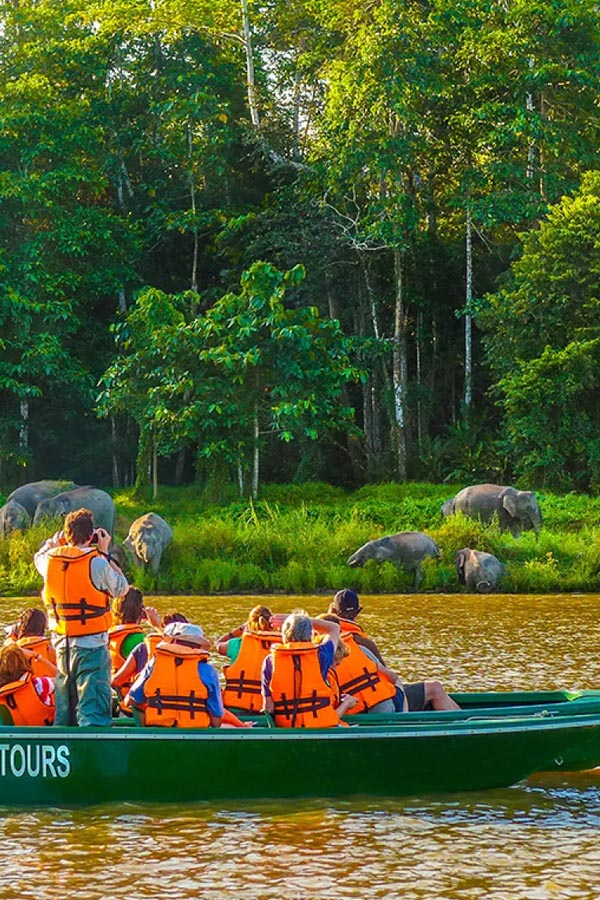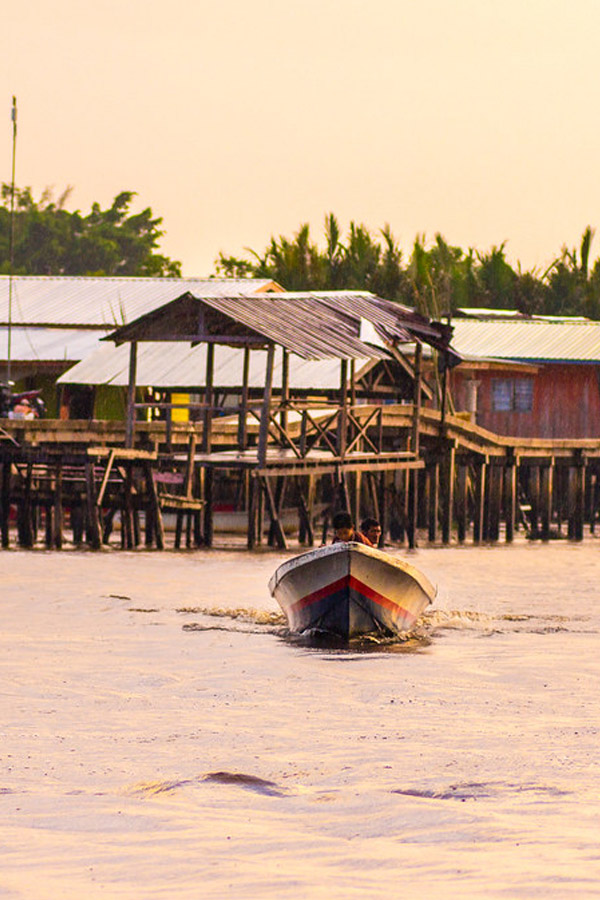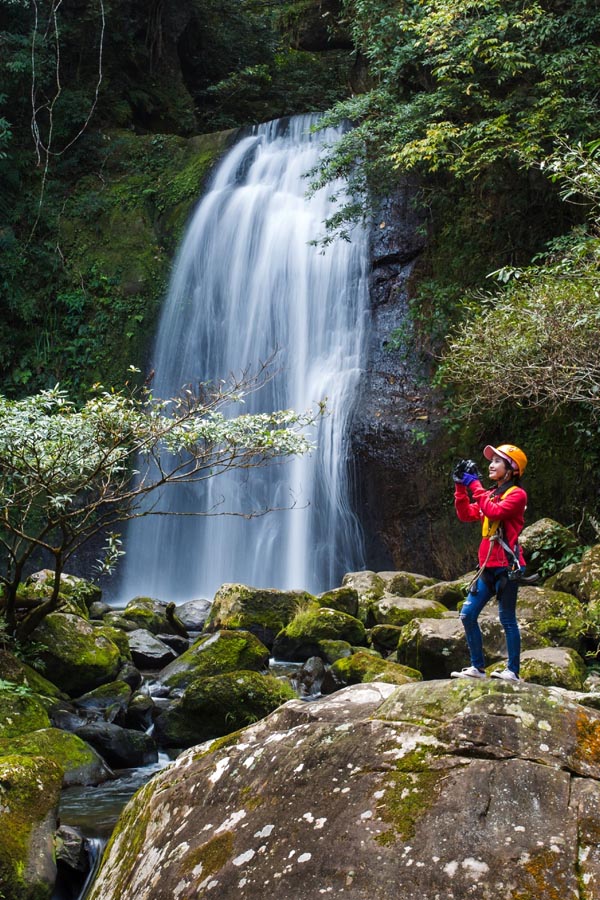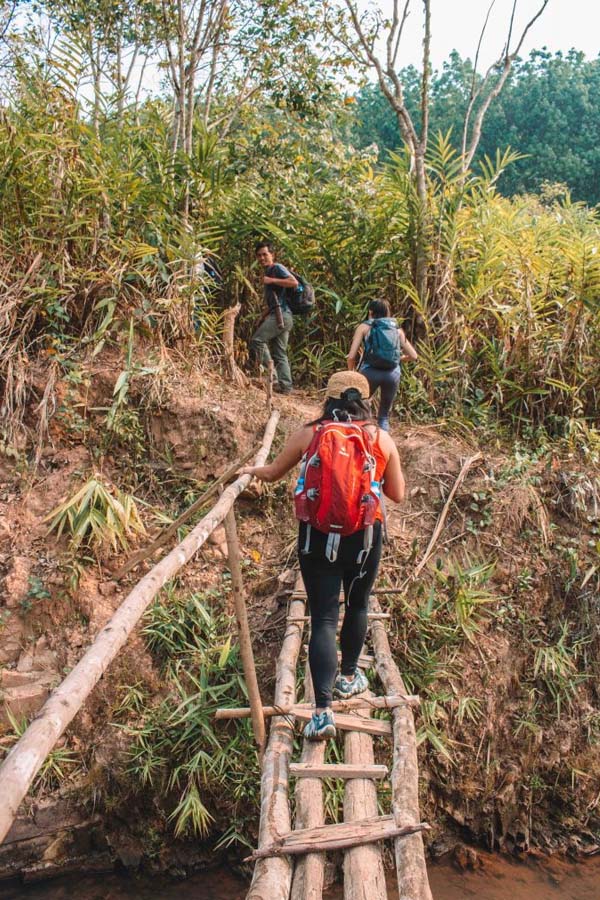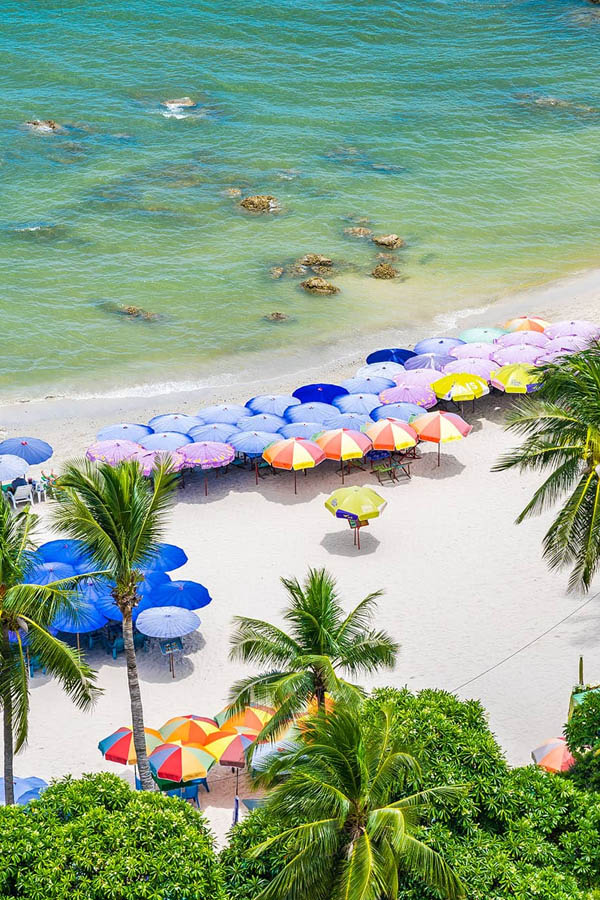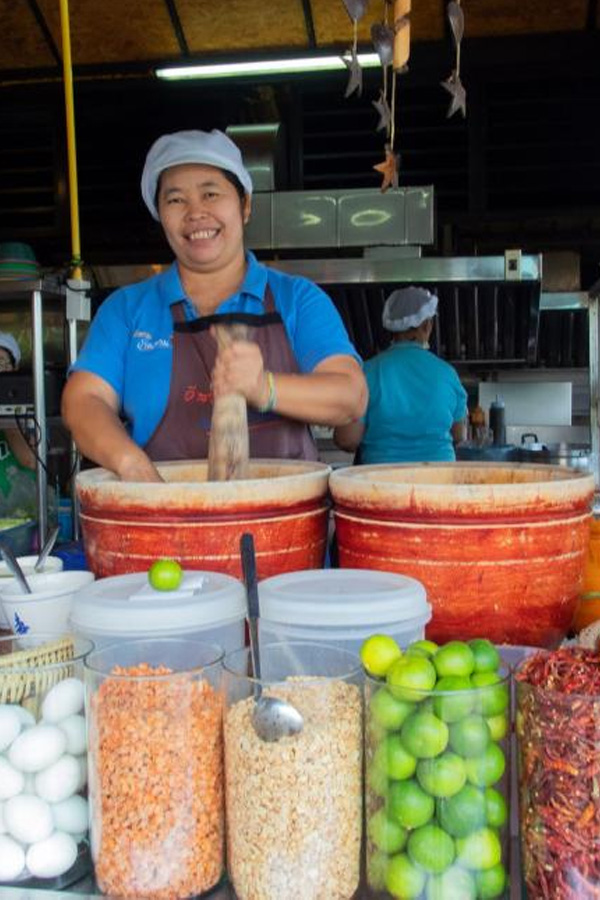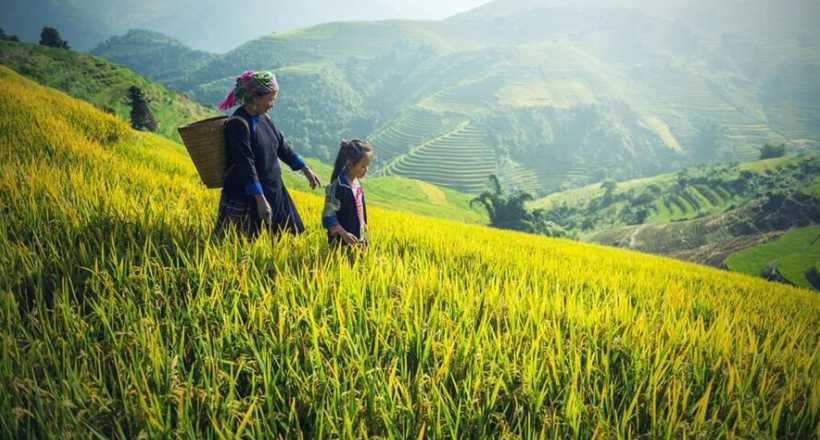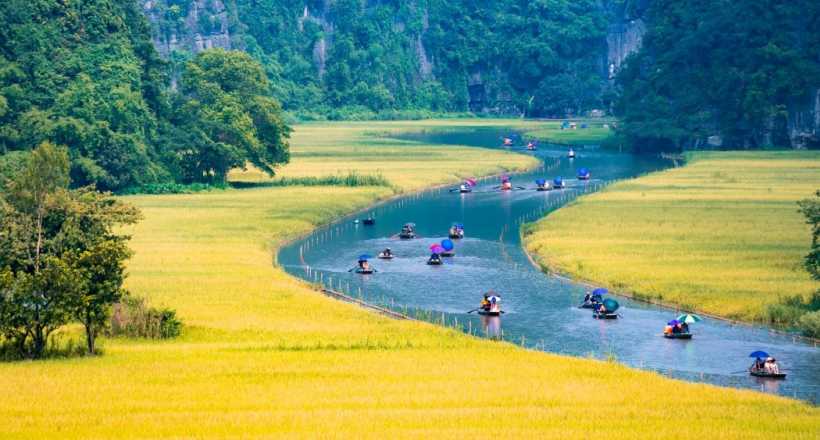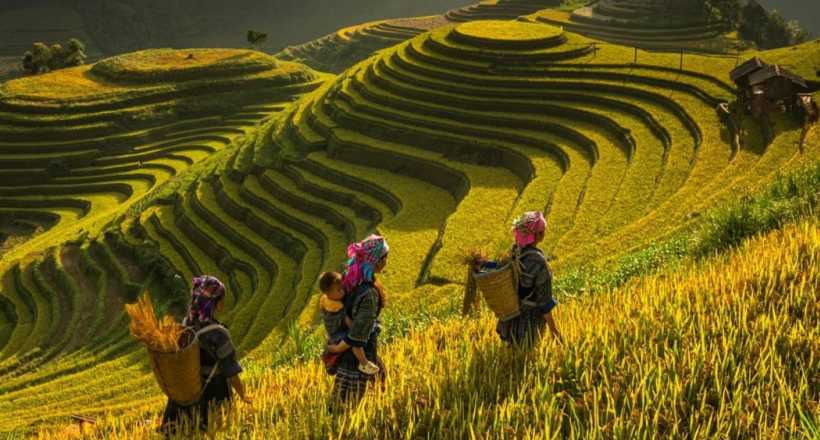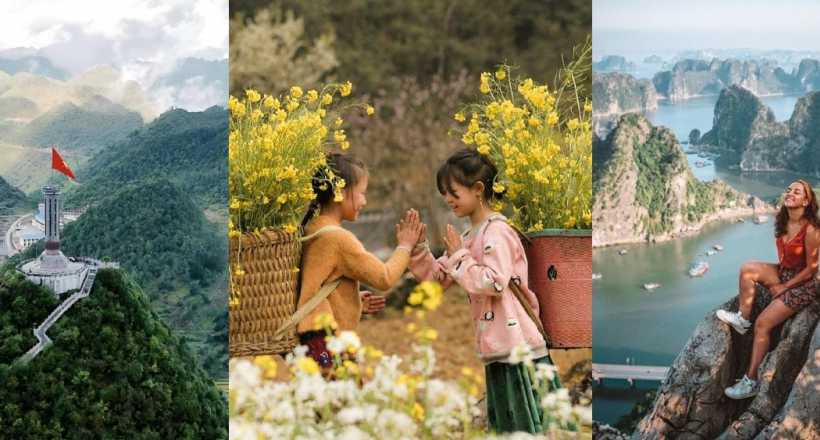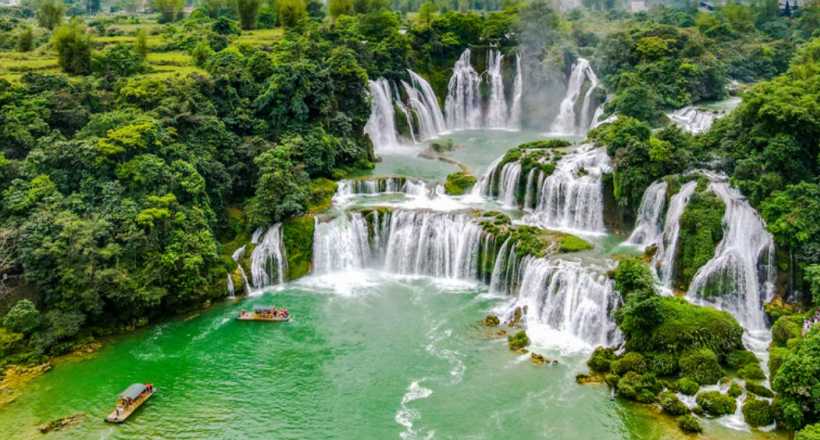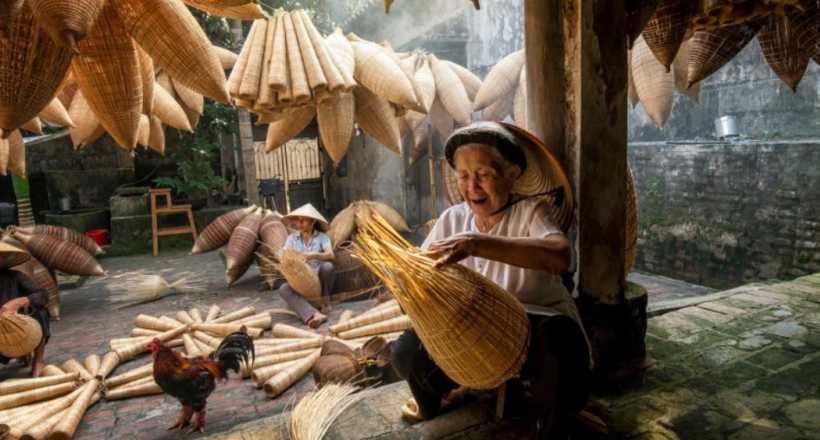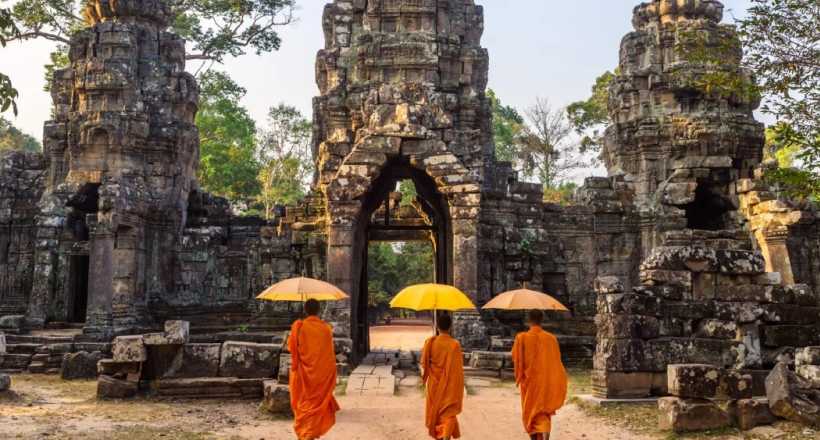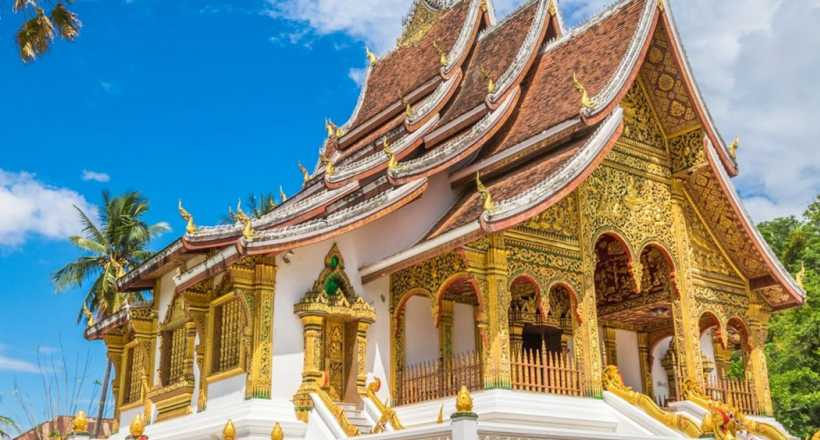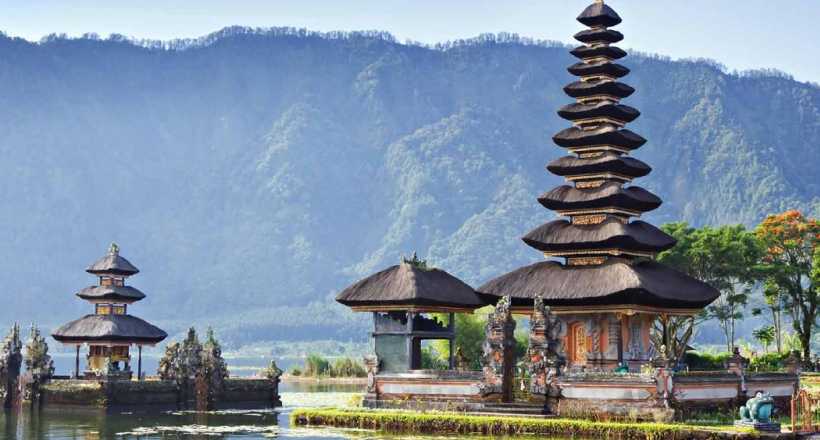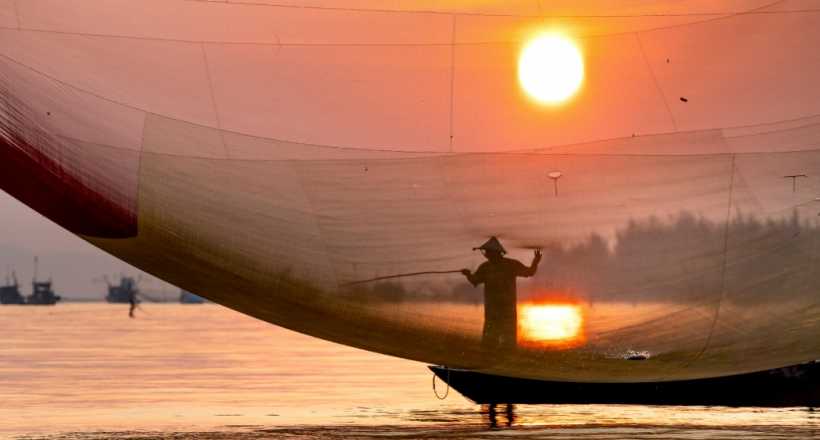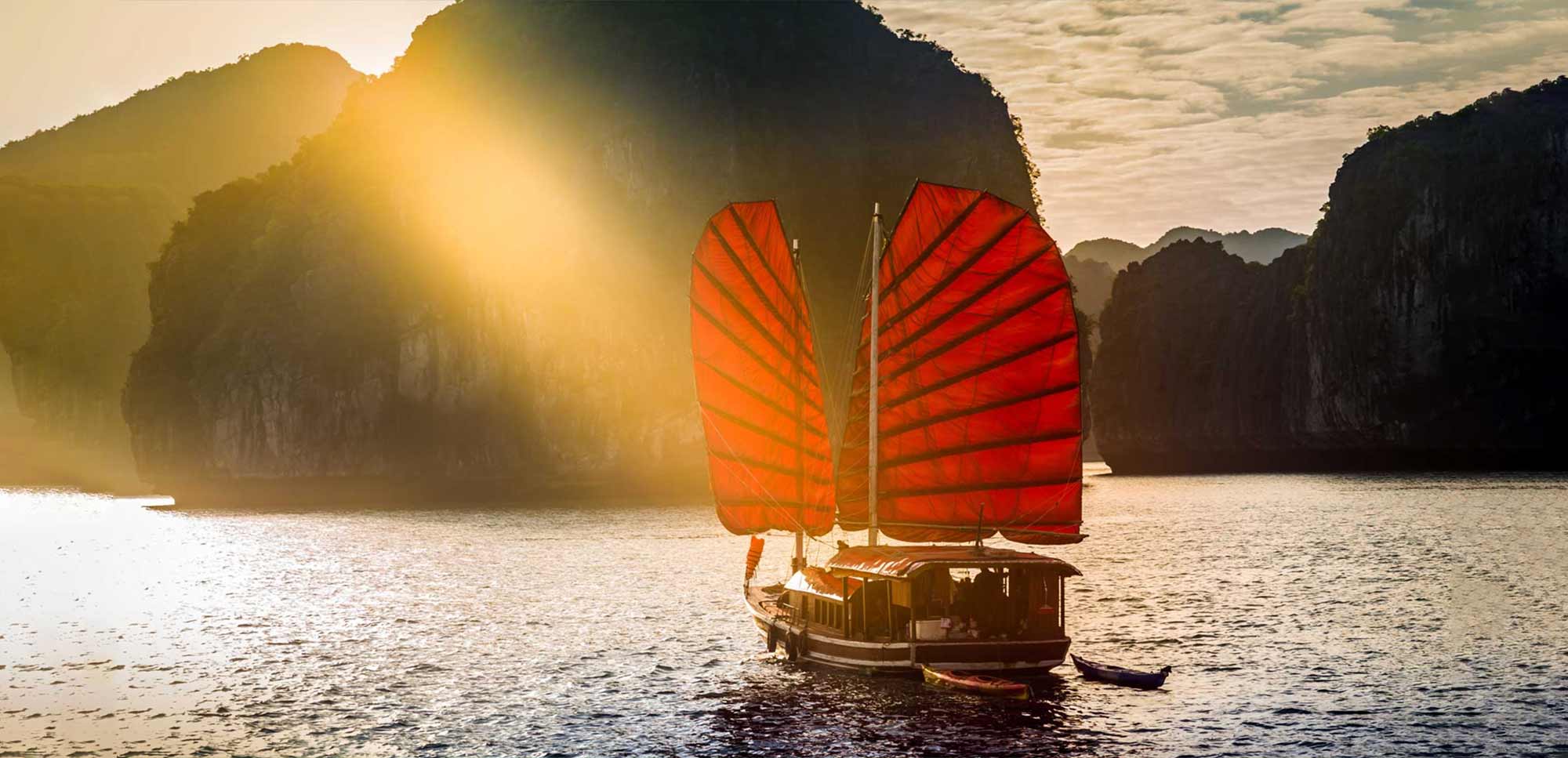
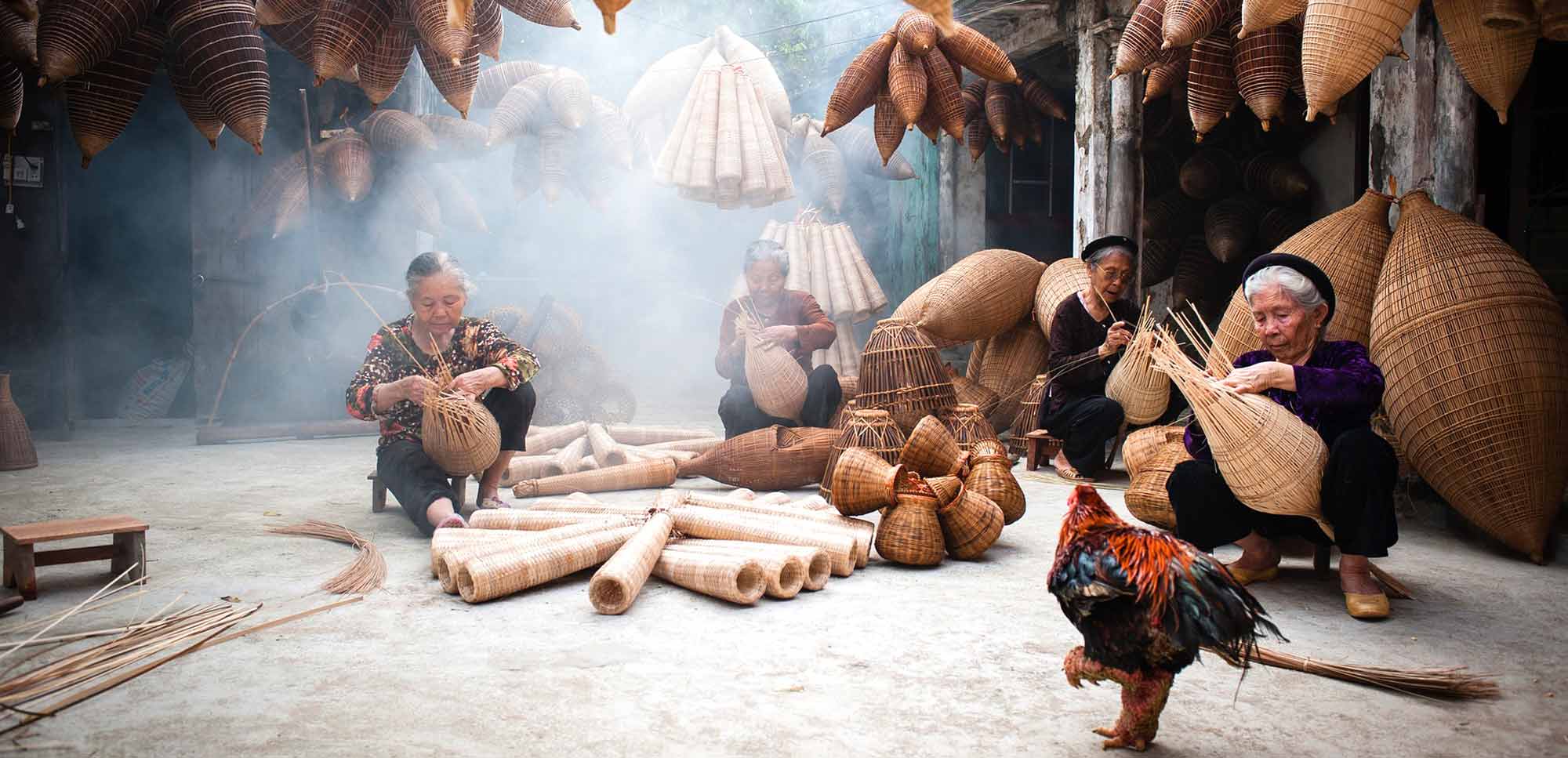
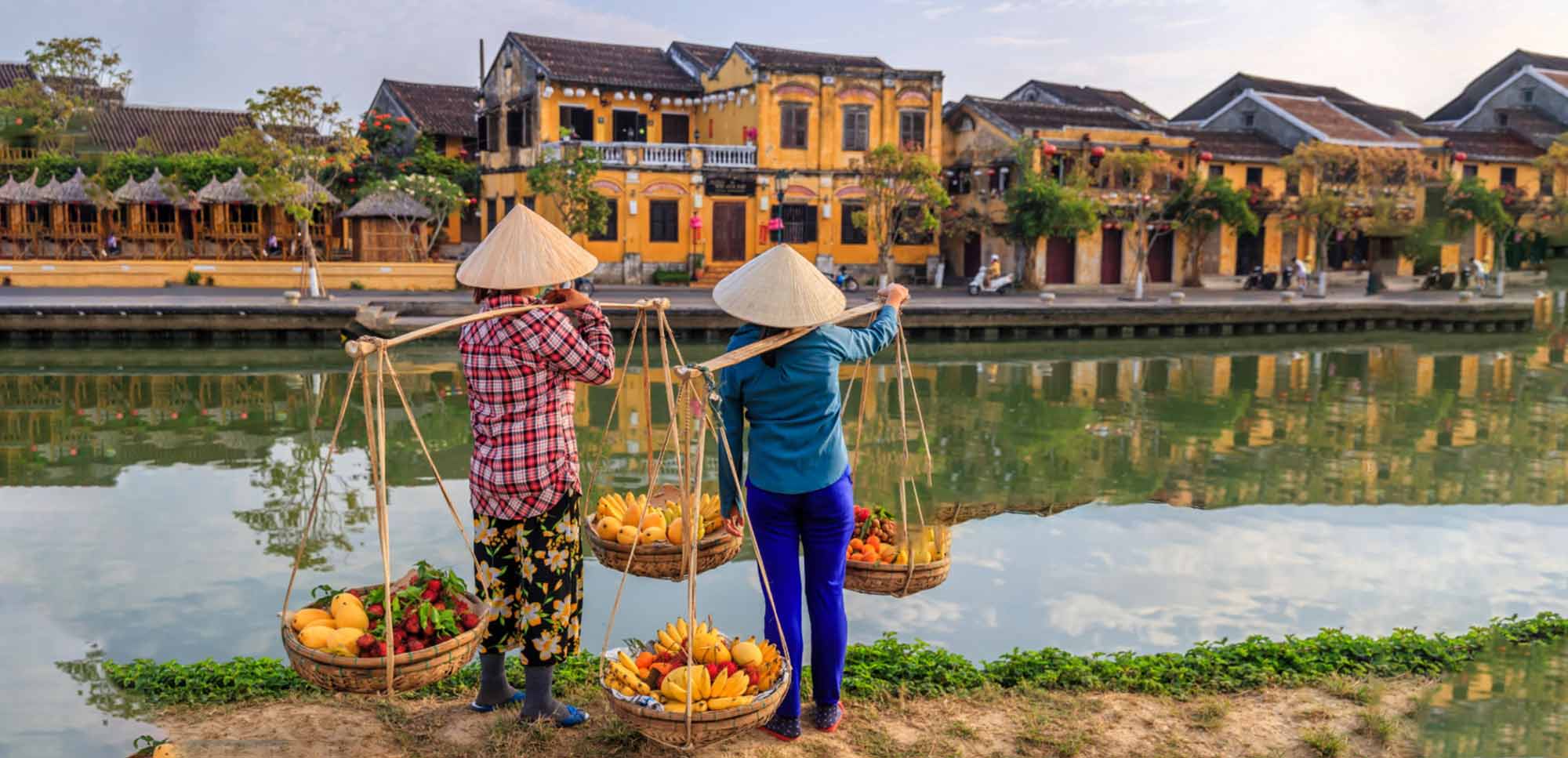
Vietnam
Timeless Beauty


CREATE YOUR OWN TRIP WITH US
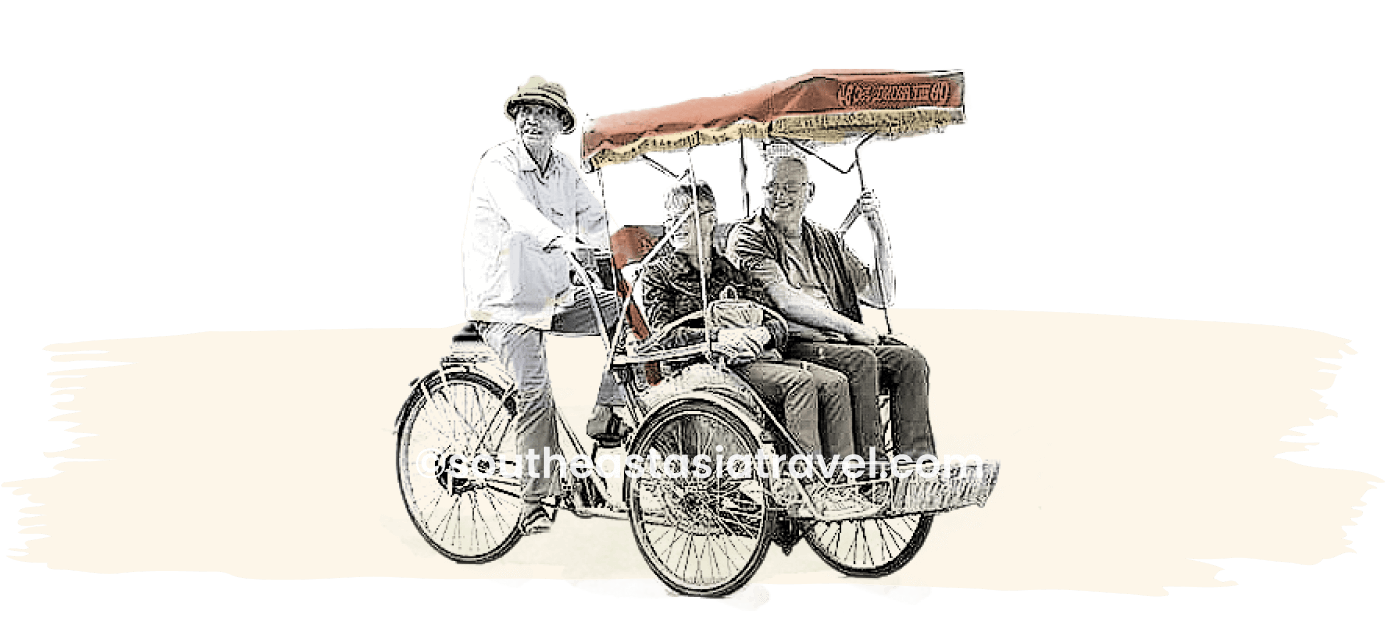
Highlights of Vietnam Tours
Ho Chi Minh City, also known as Saigon, is a bustling metropolis with rich cultural attractions that looks as much to the past as it does to the future. By day, absorb the sights and sounds of Cholon and the vibrant Chinatown and discover the secrets of Cu Chi Tunnels, the famous immense network of connecting tunnels during the Vietnam War. Then, in the evenings, get a taste of modern Vietnam by wining and dining in trendy luxury restaurants and lounges.
Head north for the slower pace of life in Hanoi, the country's cultural heart that still bears traces of centuries of change. Take a walking tour or cyclo tour through the Old Quarter Streets to see the marriage of Vietnamese and French culture and architecture; delve into traditional culture by attending a water puppet show; and meander through some of the most unique architectural structures, such as the One Pillar Pagoda, to learn about its history. Hanoi also serves as a jumping-off point for a visit to Ha Long Bay, a stunning natural landscape of emerald waters and thousands of towering limestone islands topped by rainforests. Or Mai Chau, a mountainous region where buffalo paths and rice fields unfold upon an ancient landscape that is still home to hill tribe villages.
Between Hanoi and Ho Chi Minh City lies tiny Hoi An, an ancient port town in central Vietnam that used to be an important Southeast Asian trading port between the 15th and 19th centuries CE. Here, catch a glimpse at yet another face of this fascinating travel destination — total peace and tranquility.
Read more ...
Vietnam RECOMMENDED FOR YOU
Northern Vietnam Adventure
Only From $1750 PP
All Inclusive ServiceThis Tour
Northern Vietnam Adventure
Only From $1750 PP
All Inclusive ServiceThis Tour
Unforgettable experiences along Vietnam
Only From $3864 PP
All Inclusive ServiceThis Tour
Unforgettable experiences along Vietnam
Only From $3864 PP
All Inclusive ServiceThis Tour
Highlights Of Northern Vietnam
Only From $1508 PP
All Inclusive ServiceThis Tour
Highlights Of Northern Vietnam
Only From $1508 PP
All Inclusive ServiceThis Tour
An exciting adventure in Vietnam
Only From $4608 PP
All Inclusive ServiceThis Tour
An exciting adventure in Vietnam
Only From $4608 PP
All Inclusive ServiceThis Tour
Journey of Vietnam Life & Cuisine
Only From $1672 PP
All Inclusive ServiceThis Tour
Journey of Vietnam Life & Cuisine
Only From $1672 PP
All Inclusive ServiceThis Tour
Great adventure to the amazing far-north of Vietnam
Only From $2460 PP
All Inclusive ServiceThis Tour
Great adventure to the amazing far-north of Vietnam
Only From $2460 PP
All Inclusive ServiceThis Tour
Off The Beaten Path in Northeast Vietnam
Only From $2254 PP
All Inclusive ServiceThis Tour
Off The Beaten Path in Northeast Vietnam
Only From $2254 PP
All Inclusive ServiceThis Tour
Vietnam, From South to North Odyssey
Only From $2212 PP
All Inclusive ServiceThis Tour
Vietnam, From South to North Odyssey
Only From $2212 PP
All Inclusive ServiceThis Tour
Beyond Borders: Southeast Asia
Only From $6750 PP
All Inclusive ServiceThis Tour
Beyond Borders: Southeast Asia
Only From $6750 PP
All Inclusive ServiceThis Tour
Southeast Asia Odyssey
Only From $6450 PP
All Inclusive ServiceThis Tour
Southeast Asia Odyssey
Only From $6450 PP
All Inclusive ServiceThis Tour
Thailand Malaysia Indonesia Vietnam Tour Package
Only From $5880 PP
All Inclusive ServiceThis Tour
Thailand Malaysia Indonesia Vietnam Tour Package
Only From $5880 PP
All Inclusive ServiceThis Tour
Malaysia Indonesia Thailand Vietnam Tour Package
Only From $5740 PP
All Inclusive ServiceThis Tour
Malaysia Indonesia Thailand Vietnam Tour Package
Only From $5740 PP
All Inclusive ServiceThis Tour




Vietnam
What are Vietnam Tours?
Vietnam is a vibrant and culturally rich country located in Southeast Asia, known for its stunning landscapes, historical landmarks, and diverse cuisine. From the lush, green hills of the north to the serene beaches of the south, from bustling cities to ancient towns, Vietnam offers a wide range of natural beauty and unforgettable experiences for every traveler.
Vietnam Tours refer to organized travel itineraries designed to explore Vietnam's diverse attractions, including its natural wonders, cultural heritage, historical sites, and vibrant cities. These tours typically include guided visits to iconic destinations such as Halong Bay, Hanoi, Hoi An, and Ho Chi Minh City, along with activities like trekking, cruising, food tasting, and cultural exchanges. Vietnam Tours can be open group packages with fixed departure dates or private tours tailored to suit different interests, travel styles, and budgets, offering options for adventure seekers, history enthusiasts, families, and luxury travelers alike.
Choosing a Vietnam tour ensures a seamless and enriching travel experience, offering several compelling advantages:
Hassle-Free Planning: Vietnam tours take care of all the details, from accommodations and transportation to guided activities. This allows travelers to focus on enjoying their trip without the stress of logistics.
Expert Insights: Professional tour guides provide in-depth knowledge about Vietnam’s history, culture, and local traditions, adding depth to your journey and uncovering hidden gems you might miss on your own.
Safe and Comfortable Travel: Traveling with a tour ensures safety and comfort, especially for first-time visitors to Vietnam. It offers a structured itinerary, local support, and reliable transportation.

There are two main types of Vietnam Tours, including Vietnam private tours and Vietnam group tours.
Vietnam Private Tours
Vietnam Private Tours are customized travel experiences in Vietnam tailored to the preferences of an individual, couple, family, or small group. These tours provide flexibility to explore at your own pace, as you have the freedom to adjust plans on the go, whether it’s staying longer at a certain destination, skipping attractions, or spontaneously exploring hidden gems that interest you. You can enjoy exclusive attention from your guide, who can offer personalized recommendations and introduce you to off-the-beaten-path spots that you may not discover in a group tour, ensuring a more authentic and unique experience.
A private Vietnam tour often includes high-quality transportation, allowing you to travel in comfort. You won’t have to deal with crowded public transport, and there’s a greater focus on your relaxation and preferences. Private tours also maximize your time so that you can visit multiple sites in a day without unnecessary delays or detours, making it ideal for those with limited time.
The drawback is that private Vietnam tours can be more expensive compared to group tours, as you are paying for the full cost of the guide and transportation.
Advantages of Vietnam Private Tours:
Personalized Experience: Vietnam Private tours are fully customizable, allowing you to design your itinerary according to your interests. Whether you're into history, nature, or local cuisine, you can focus on what excites you most.
Flexibility: With a Vietnam private tour, you can adjust your schedule as needed. If you want to spend more time in a particular place or skip an attraction, the choice is yours.
Exclusive Attention: Since it’s just you or your group, the guide can provide more in-depth information and personalized service, ensuring a deeper and more tailored experience.
Comfort and Privacy: Private tours often offer more comfortable transportation and accommodations, and you’ll enjoy greater privacy and intimacy during your trip.
Disadvantages of Vietnam Private Tours:
Higher Cost: Vietnam Private tours tend to be more expensive than group tours, as you are paying for the full cost of the guide, transportation, and sometimes luxury accommodations.
Limited Social Interaction: If you're someone who enjoys meeting new people while traveling, a private tour may feel more isolated, as it's just you and your group.
Planning Effort: While private tours are more flexible, they may require more input and planning from you to create the perfect itinerary, especially if you want to customize every aspect of the trip on your own.
Vietnam Group Tours
Vietnam Group Tours are pre-arranged travel itineraries in Vietnam where participants join a group of travelers, often led by a tour guide. These tours offer several advantages, including cost savings, as sharing expenses with others makes the trip more affordable. They also provide the benefit of a social experience, allowing you to meet fellow travelers and enjoy shared activities. Additionally, group tours are well-organized, with guides handling logistics, transportation, and itineraries, which can save you time and reduce stress. However, the downside is that group tours tend to follow a set schedule, offering less flexibility. You may have limited time at each destination, and personal preferences or interests might not always align with the group’s itinerary.
Advantages of Vietnam Group Tours:
Cost-Effective: Group tours are generally more affordable since the costs for transportation, guides, and accommodations are shared among the participants.
Social Experience: Group tours provide an opportunity to meet new people from around the world, making them ideal for solo travelers or those who enjoy socializing.
Well-Organized: With a set itinerary, group tours are typically well-structured, ensuring that you visit all the key attractions in a limited time, often with everything included (transportation, meals, tickets, etc.).
Group Discounts: Larger groups can sometimes take advantage of special discounts for activities, accommodations, or meals.
Disadvantages of Vietnam Group Tours:
Less Flexibility: Group tours have a fixed schedule and itinerary, meaning you may have to skip attractions or rush through activities that you would prefer to explore at your own pace.
Crowded Conditions: With a group, you may feel limited in terms of personal space, and large numbers of people can sometimes detract from the experience, especially at popular tourist sites.
Impersonal: With multiple participants, you may not get as much individual attention from the guide, and your personal interests may not always align with the group’s activities.
Why choose Vietnam Tours?
Stunning Natural Landscapes in Vietnam
From the emerald waters and towering limestone karsts of Halong Bay to the terraced rice fields of Sapa, each destination in Vietnam offers a unique charm. The lush green valleys of Ninh Binh, often called the “Halong Bay on land,” are a haven for nature lovers, while the sand dunes of Mui Ne provide a striking desert-like contrast. In central Vietnam, the caves of Phong Nha-Ke Bang National Park, including the world-famous Son Doong Cave, offer an otherworldly experience. Whether exploring misty mountains, serene rivers, or pristine beaches, Vietnam's diverse natural landscapes leave an indelible mark on every visitor.
Vietnam is Rich in Cultural Heritage
Vietnam is a country rich in cultural heritage, boasting a history that spans thousands of years and a tapestry of traditions shaped by diverse influences. From the ancient temples of Hue's Imperial City to the charming old town of Hoi An, Vietnam preserves its historical legacy with pride. Traditional festivals like Tet (Lunar New Year) and the Mid-Autumn Festival showcase vibrant customs and rituals deeply rooted in the nation’s identity. The ethnic diversity of Vietnam, with 54 recognized ethnic groups, further enriches its cultural landscape, offering unique languages, crafts, and culinary traditions. This cultural wealth is a testament to Vietnam’s resilience and creativity, making it a captivating destination for history and culture enthusiasts.
Abundant Vietnamese Culinary Delights
Vietnam is a paradise for food lovers, offering an abundance of culinary delights that reflect its rich culture and regional diversity. From the fragrant bowls of pho and savory banh mi sandwiches to the fresh, herb-packed goi cuon (spring rolls), every dish is a harmonious blend of flavors and textures. Each region contributes its specialties, like the spicy dishes of Hue, the hearty fare of the north, and the sweet-savory creations of the Mekong Delta. With its emphasis on fresh ingredients, bold spices, and meticulous preparation, Vietnamese cuisine is a feast for the senses and a highlight of any visit to the country.
Vietnam Offers Warm Hospitality
Vietnamese people are known for their friendliness, generosity, and willingness to share their rich culture and traditions with guests. Whether exploring bustling cities, tranquil villages, or remote mountain regions, travelers often experience heartfelt smiles and genuine kindness. Homestays, local markets, and community tours offer authentic opportunities to connect with locals and learn about their daily lives. This spirit of openness and warmth leaves a lasting impression, ensuring that Vietnam is not just a destination but a place of meaningful connections.
Affordability of Vietnam Tours
Vietnam is an ideal destination for travelers seeking affordability without compromising on rich experiences. From budget-friendly accommodations and inexpensive local eateries to reasonably priced guided tours, the country offers excellent value for money. Affordable public transport, like trains and buses, further enhances accessibility, making Vietnam an attractive option for budget-conscious adventurers.

Best time to take Vietnam Tours
In general, the best time to visit Vietnam is during the spring (March to April) and autumn (September to November), when the weather is generally mild and favorable across the country. During these months, northern regions like Hanoi and Halong Bay enjoy cool, dry weather, while central areas such as Hoi An and Hue experience pleasant warmth with minimal rainfall. In the south, Ho Chi Minh City and the Mekong Delta have sunny skies and manageable humidity. These transitional seasons offer ideal conditions for exploring Vietnam’s diverse landscapes, cultural sites, and outdoor activities, making them the most recommended times for a well-rounded trip.
Best time to visit Northern Vietnam (Hanoi, Halong Bay, Sapa):
Northern Vietnam experiences a humid subtropical climate with four distinct seasons: spring, summer, autumn, and winter. Winters (from December to February) can be cold, especially in the mountainous areas like Sapa, where temperatures can drop to near freezing. Spring and autumn (March to May, September to November) are the most pleasant, with mild temperatures and low humidity. Summer (June to August) is hot and humid, with temperatures often exceeding 30°C (86°F) and occasional rainstorms.
Best time to visit northern Vietnam: from October to April
Best time to visit Central Vietnam (Hue, Da Nang, Hoi An):
Central Vietnam has a tropical monsoon climate, with a clear distinction between the wet and dry seasons. The dry season runs from February to August, with warm, sunny weather and temperatures ranging from 25°C to 35°C (77°F to 95°F). The wet season lasts from September to January, with heavy rainfall, particularly in the coastal areas, and the risk of typhoons in the fall months.
Best time to visit central Vietnam: from February to August
Best time to visit Southern Vietnam (Ho Chi Minh City, Mekong Delta):
Southern Vietnam has a tropical climate with a distinct wet and dry season. The dry season, from December to April, is hot and sunny, with temperatures typically ranging from 25°C to 35°C (77°F to 95°F). The wet season runs from May to November, characterized by heavy afternoon rains, though it’s usually short-lived and does not disrupt travel significantly. Humidity is high year-round, making the climate feel warmer than the actual temperature.
Best time to visit southern Vietnam: from November to April
What you can expect from Vietnam Tours
- Get an overview of Vietnamese history and culture through city highlights in the capital of Hanoi, such as the Ho Chi Minh Complex, the One Pillar Pagoda, the Temple of Literature, the Museum of Ethnology, etc.
- Relax on board an overnight cruise in Halong Bay, take in the breathtaking seascapes, and refresh yourselves by joining exciting activities like kayaking, swimming, visiting caves, and watching the sunrise with a Tai Chi class.
- Go on a relaxing boat ride that winds peacefully between the natural limestone mountains and lush rice fields along the Ngo Dong River to explore the picturesque landscapes and three natural caves of Tam Coc.
- Trek through Sapa’s fantastic mountain landscapes of rice-terraced fields, rainforests, and waterfalls to some ethnic minority villages of the Hmong, Giay, and Red Dao people, where you can learn about their local life, culture, and traditions.
- Take a boat trip through the mesmerizing allure of the Nho Que River in Ha Giang, an absolute must for avid travelers seeking an unforgettable experience in the far north of Vietnam, and marvel at Tu San Abyss Alley, one of the most magnificent canyons in Southeast Asia.
- Get off the beaten path to Pu Luong, home to spectacular limestone landscapes and terraced rice paddies in northwest Vietnam, where you can wander around ethnic minority villages, observe the local life, and explore distinct cultures.
- Leisurely walk around the tranquil villages of Thai ethnic people in Mai Chau, stop at the beautifully authentic stilt houses and lush rice fields, and enjoy a delicious local Thai dinner with traditional wine.
- Escape the city life to go deep into the wildness of Phong Nha Ke Bang National Park and get the feeling of "standing in the middle of nowhere" when trekking through lush jungles and exploring hidden caves.
- Enjoy a fascinating tour around the notable sights and UNESCO-listed monuments of Hue, including the Forbidden Purple City and the impressive imperial tombs of the Nguyen Dynasty, the last dynasty of Vietnam, and the Thien Mu Pagoda, the oldest pagoda in the city.
- Experience the world's longest single-wire cable car system in the action-packed Ba Na Hills, walk along the foggy Golden Bridge to enjoy gorgeous views of Danang City, and take iconic photos of the giant hands.
- Get lost in the peaceful Hoi An Ancient Town under hundreds of colorful lanterns, visit ancient houses and historic sites, and be captivated by the unique yellow ochre walls, which are amazing backdrops for stunning photos.
- Explore the glorious past of the ancient Kingdom of Champa at the breathtaking My Son Sanctuary, a holy cluster of abandoned and ruined Hindu temples recognized as a UNESCO World Heritage Site in 1999.
- Discover Da Lat in the Central Highlands, a cool, pleasant heaven for wellness seekers and outdoor enthusiasts, with many amazing natural wonders, European-inspired architecture, and delicious street food.
- Go underground at the Cu Chi Tunnels for a Vietnam history lesson and see the dynamic Ho Chi Minh City through iconic landmarks: Reunification Palace, War Remnants Museum, Post Office, Notre-Dame Cathedral...
- Embark on an exciting boat trip to see the ever-changing scenery and explore the authentic local life in the Mekong Delta, with visits to fascinating floating markets, traditional workshops, lush farms and plantations, and ancient houses.
- Have fun on the sunny and windy coastline with bleached sandy beaches and clear emerald waters of Nha Trang, join plenty of water activities like swimming, snorkeling, or surfing, and collect unforgettable memories.
- Get away from daily stress with a relaxing break on Mui Ne's long sandy beaches, which are great for couples and families having a walk, jogging, and witnessing spectacular sunsets over the sea.
- Cherish your time on the best reefs and sun-drenched tropical beaches of Phu Quoc, or experience all the highlights of the town at your own pace, such as pepper farms, historic pagodas, fish sauce factories, fishing villages, and more.

Most Popular Destinations on Vietnam Tours
Hanoi
One city, two sides, yin and yang - an ancient culture and modern influence, tranquility and chaos, tradition and innovation. The capital of Vietnam maintains a captivating balance between retaining the original charm of its rich history and culture and adapting it to contemporary values from around the world. The face of Hanoi includes the villas of the former French colonial period, the iconic old condominiums, tree-lined boulevards, a world of cafes, some great northern Vietnamese cuisine, and its unforgettable, noisy, colorful street life.
Halong Bay
If you are staying in Hanoi, there is undoubtedly no better way to escape the city’s bustling life than by cruising Halong Bay overnight. This UNESCO World Heritage site is famed for its stunning limestone karsts that rise dramatically from the bay’s deep blue waters. Watch the sun set from the cruise ship’s deck and fall asleep to the gentle sound of waves lapping against the boat.
Sapa
Trekking is a must when visiting Sapa. This former French hill station, established in the late 1880s, has a network of trails to trek, suitable for all levels - from easy to the more challenging routes. Hike through ethnic minority villages, pass terraced rice fields and rolling mountains, and get a glimpse into the local cultures nestled within Sapa’s stunning natural beauty.
Ninh Binh
Often referred to as “Halong Bay on land”, Ninh Binh’s landscape is famed for its jagged limestone peaks rising from flat rice paddies and its mellow streams meandering through this incredible landscape. Sampan boats, rowed by the local people, lead you on a journey through this karst scenery, floating through tunnels and caves, surrounded by colossal limestone outcrops. It is also well worth climbing the 500 steps up Hang Mua Peak for a spectacular bird’s-eye view of the area.
Hue
Hue, located in Central Vietnam, is best known for its royal mausoleums, the former imperial citadel, and iconic pagodas. Boasting a fantastic and rich cuisine, the city is not only a favorite destination for those who love architecture, but it is also a mecca for those on a gastronomic tour. For history buffs, the region still has several remnants from the Vietnam War, such as a military base and tunnels in the DMZ.
Da Nang
Da Nang is the busiest tourist city in central Vietnam, and it is used as a springboard for visiting three worldwide famous heritage sites – the Hue Imperial Capital, My Son Sanctuary, and Hoi An ancient town. It is also famed for its powdery white sands and crystal-clear seas, making it an ideal beach resort holiday.
Hoi An
Hoi An, awash with its famous bright yellow ochre facades, has retained a wealth of cultural and historical attractions. Meander the narrow alleyways of the ancient town, where medieval two-story wooden buildings seem frozen in time. See Hoi An at night, brimming with a myriad of colorful lanterns; visit the old congregation halls of the town’s former Chinese community; sample a huge variety of cuisine; hire a bike and cycle down the alleys and lanes and further afield to explore the surrounding countryside.
Ho Chi Minh City
Cosmopolitan Ho Chi Minh City is Hanoi’s southern counterpart. It is Vietnam’s largest city and the country’s business and financial center. Visit the War Remnants Museum and the Reunification Palace, sip coffee at one of the many picturesque coffee shops, and party the night away at some of Vietnam’s best rooftops.
The Mekong Delta
The Mekong Delta neighbors Ho Chi Minh City, making it close enough to visit on a day tour. Explore the waterways, mangrove forests, and lush green rice fields where life is governed by the ebb and flow of Southeast Asia’s most iconic river – the Mekong River. For an immersive experience, we recommend spending one or two nights in one of the riverside towns or taking a longer trip to travel by boat down the Mekong into Cambodia.
Phu Quoc
Lapping jewel-blue waters edged by fine sandy beaches, Phu Quoc Island is a place to enjoy the sun, surrounded by a breathtaking natural environment. This is Vietnam’s largest island (the size of Phuket in Thailand) and is a scuba diving and snorkeling paradise. Incidentally, Phu Quoc is Vietnam’s only locality offering a 30-day visa-free entry.
Vietnam Tours by Styles
Vietnam, with its rich culture, stunning landscapes, and vibrant history, offers a wide range of travel experiences to suit every type of traveler. Vietnam Tours by Styles caters to diverse interests and preferences, allowing visitors to explore the country through different thematic lenses. Whether you're seeking adventure in the rugged mountains, relaxation on the pristine beaches, cultural immersion in ancient towns, or gourmet exploration of the local cuisine, there is a tour style to match your desires.
Best-selling Vietnam Tours
Best-Selling Vietnam Tours refer to the most popular travel packages in Vietnam, chosen by our Inside Travel experts for their well-crafted itineraries, iconic destinations, and exceptional value. These tours often include visits to highlights like Halong Bay, Hanoi, Hoi An, and Ho Chi Minh City, combined with activities such as cultural experiences, cruises, and culinary adventures. They are designed to provide a memorable and comprehensive exploration of Vietnam’s natural beauty, history, and vibrant culture.
Vietnam Heritage & Culture Tours
Heritage & Culture Vietnam Tours are designed to immerse travelers in the rich history, traditions, and cultural heritage of Vietnam. These tours focus on exploring ancient towns, UNESCO World Heritage sites, and dynamic local communities. Highlights may include visits to the Imperial Citadel of Hue, the ancient town of Hoi An, the historic temples of Hanoi, and interactions with indigenous ethnic groups in the northern mountains. Travelers will gain insights into Vietnam’s art, architecture, cuisine, and customs, offering a deeper understanding of the country’s unique cultural tapestry. These tours are perfect for those seeking to connect with the soul of Vietnam through its past and present.
Nature & Wildlife Vietnam Tours
Nature & Wildlife Vietnam Tours are ideal for nature lovers and wildlife enthusiasts wishing to explore Vietnam's diverse ecosystems and rich biodiversity. These tours provide visits to the country’s famous natural wonders, national parks, or wildlife sanctuaries, where travelers can enjoy a deep connection to Vietnam's stunning landscapes while promoting environmental conservation and sustainability. Iconic experiences include birdwatching in Cuc Phuong National Park, boating through cajuput forests in the Mekong Delta, trekking through the lush Phong Nha-Ke Bang, and observing flora and fauna in Nam Cat Tien National Park.
Adventure & Outdoor Vietnam Tours
Adventure & Outdoor Vietnam Tours are crafted for thrill-seekers and nature enthusiasts looking to explore the country's rugged landscapes and take part in exciting outdoor activities. These tours offer a range of adventures, from trekking through the terraced rice fields of Sapa, kayaking in Halong Bay, and cycling through the Mekong Delta to challenging mountain climbs and jungle expeditions. With a focus on active exploration, these tours immerse travelers in Vietnam's diverse natural beauty, offering a perfect blend of adrenaline, discovery, and stunning scenery for those eager to experience the wild side of the country.
Beach & Island Vietnam Tours
Beach & Island Vietnam Tours refer to travel packages or itineraries designed to explore Vietnam's coastal regions, islands, and beaches. These tours take travelers to visit some of the country’s most picturesque and tranquil seaside destinations, including famous spots like Phu Quoc, Da Nang, and Nha Trang. The tours typically include activities such as lounging on pristine beaches, snorkeling, diving, island hopping, and exploring local culture and wildlife. Whether for relaxation or adventure, these tours are ideal for those seeking a mix of natural beauty, recreation, and a peaceful escape in Vietnam's coastal paradise.
Vietnam Family Tours
Family Vietnam Tours are specially designed travel experiences tailored to accommodate the needs and interests of families traveling together. These tours intend to create enjoyable, safe, and educational experiences for all ages, from young children to grandparents. The itineraries typically include family-friendly activities, such as visits to cultural sites, wildlife encounters, interactive workshops, and outdoor adventures. With a balance of relaxation and exploration, Family Vietnam Tours allow families to discover Vietnam's rich history, stunning landscapes, and inspiring culture in a way that everyone can enjoy together.
Honeymoon Vietnam Tours
Honeymoon Vietnam Tours are curated travel itineraries designed for couples seeking a romantic and memorable getaway in Vietnam. These tours offer intimate and relaxing experiences in scenic destinations, with activities like private beach escapes, overnight cruises, luxurious spa treatments, and visits to stunning natural wonders. Whether exploring the lush landscapes of Halong Bay, the charming streets of Hoi An, or the wondrous culture of Hanoi, Honeymoon Vietnam Tours are crafted to provide couples with a perfect blend of romance, adventure, and tranquility as they celebrate their new life together.

Where to Stay on Vietnam Tours
Vietnam offers a diverse range of accommodations to suit every traveler's needs, from budget-friendly hostels to luxurious five-star resorts. Whether you're exploring bustling cities like Hanoi and Ho Chi Minh City, relaxing on pristine beaches in Da Nang or Phu Quoc, or trekking through the lush mountains of Sapa, you'll find a variety of options to match your style and budget. Travelers can choose from traditional homestays for an authentic cultural experience, boutique hotels with modern amenities, or eco-lodges in scenic countryside locations. With warm hospitality and competitive prices, Vietnam ensures a comfortable stay for visitors while showcasing its rich culture and natural beauty.
Hanoi
3-star Bonsell Hotel - 03 Bao Khanh Street, Hoan Kiem District, Hanoi
4-star Tirant Hotel - No 38 Gia Ngu Street, Hoan Kiem District, Hanoi
5-star Hotel de l'Opera Hanoi - 29 Trang Tien Street, Hoan Kiem District, Hanoi
Halong Bay
4-star Sena Cruise
4-star Peony Cruise
5-star Orchid Classic Cruise
Sapa
3-star Sapa Dragon Hotel - 01A, Thac Bac Street, 333108 Sapa, Lao Cai
4-star Pistachio Hotel Sapa - No 29, Group 5, Thac Bac Street, Sapa, Lao Cai
5-star Silk Path Grand Sapa Resort & Spa - Doi Quan 6, Group 5, Sapa, Lao Cai
Ninh Binh
3-star Liberty Hall Tam Coc Hotel & Villa - Van Lam Hamlet, Ninh Hai Commune, Hoa Lu District, Ninh Binh
4-star Ninh Binh Hidden Charm Hotel & Resort - No 9, Tam Coc - Bich Dong Tourist Center, Ninh Thang, Hoa Lu, Ninh Binh
5-star Emeralda Resort Ninh Binh - Van Long Reserve, Gia Van Commune, Gia Vien District, Ninh Binh
Hoi An
3-star Emerald Hoi An Riverside Resort - 127 Ngo Quyen, Minh An, Hoi An, Quang Nam
4-star Vinh Hung Riverside Resort & Spa - 111 Ngo Quyen Street, An Hoi Islet, Hoi An, Quang Nam
5-star Hotel Royal Hoi An - Gallery - 39 Dao Duy Tu Street, Hoi An, Quang Nam
Hue
3-star Romance Hue Hotel - 16 Nguyen Thai Hoc Street, Phu Hoi, Hue
4-star Eldora Hotel - 60 Ben Nghe Street, Phu Hoi, Hue
5-star BWP Indochine Palace Hotel - 105A Hung Vuong Street, Phu Nhuan, Hue
Da Nang
4-star Vanda Hotel - 03 Nguyen Van Linh Street, Hai Chau, Danang
4-star Haian Beach Hotel & Spa - 278 Vo Nguyen Giap Street, Ngu Hanh Son, Da Nang
5-star Pullman Danang Beach Resort - 101 Vo Nguyen Giap Street, Ngu Hanh Son, Da Nang
Ho Chi Minh City
3-star Sanouva Saigon Hotel - 175 Ly Tu Trong Street, Ben Thanh, District 1, Ho Chi Minh City
4-star Liberty Central Saigon Citypoint - 59 Pasteur Street, Ben Nghe, District 1, Ho Chi Minh City
5-star Hotel Majestic Saigon - 1 Dong Khoi Street, Ben Nghe, District 1, Ho Chi Minh City
Mekong Delta
Homestay Coco Riverside Lodge - Phu An, Trung Nghia, Vung Liem, Vinh Long
Homestay Ut Trinh Vinh Long - Hoa Qui, Hoa Ninh, Long Ho, Vinh Long
4-star Victoria Can Tho Resort - Cai Khe, Ninh Kieu, Can Tho
Phu Quoc
3-star Sea Star Phu Quoc Resort - 98/2 Tran Hung Dao Street, Duong Dong Town, Phu Quoc, Kien Giang
4-star Cassia Cottage Resort - 100C/12 Tran Hung Dao Street, Duong Dong, Phu Quoc, Kien Giang
5-star La Veranda Resort Phu Quoc - Tran Hung Dao Street, Duong Dong, Phu Quoc, Kien Giang
Must-try Food on Vietnam Tours
Pho Bo (Beef Noodle Soup) - Hanoi
Hanoi beef noodle soup, known as Phở Bò, is a beloved Vietnamese dish that originated in the capital city of Hanoi. It features a fragrant broth made from simmering beef bones, spices, and herbs for hours, resulting in a rich, savory base. The soup is served with thin rice noodles and tender slices of beef, often accompanied by fresh herbs, bean sprouts, lime, and chili. The balance of flavors - umami, freshness, and a hint of sweetness - makes phở bò a comforting and flavorful meal, enjoyed at any time of day, especially for breakfast. Its iconic status in Vietnamese cuisine makes it a must-try for food lovers.
Banh Mi (Bread)
Bánh mì is a Vietnamese sandwich that blends French influence with local flavors, featuring a light, crispy baguette filled with a variety of savory ingredients. Typically, it includes meats such as grilled pork, chicken, or pâté and is topped with fresh herbs, pickled vegetables, cucumber, and a dash of chili. The contrast between the crunchy, airy bread and the flavorful fillings makes bánh mì a delicious and satisfying street food enjoyed throughout Vietnam. Its versatility allows for endless variations, making it a beloved snack or meal for any time of day.
Bun Cha - Hanoi
Bún chả is a popular Vietnamese dish that originated in Hanoi. It consists of grilled pork, often served as pork patties (chả) or grilled pork belly, which is charred to perfection over an open flame. The grilled meat is served in a bowl of savory, slightly sweet broth, alongside a plate of cold rice noodles (bún) and a variety of fresh herbs and vegetables. The dish is often enjoyed by dipping the meat and noodles into the flavorful broth, offering a delicious balance of smoky, savory, and fresh flavors. Bún chả is a favorite street food in Hanoi, enjoyed for lunch or dinner, and is famously associated with the iconic scene of President Obama dining with Anthony Bourdain in 2016.
Bun Bo (Hue Beef Noodle Soup) - Hue
Bún bò Huế is a flavorful and aromatic Vietnamese noodle soup that hails from Hue. Known for its rich and spicy broth, it is made by simmering beef bones with lemongrass, shrimp paste, and chili, resulting in a deep, complex flavor profile. The dish features rice noodles (bún) and a combination of tender beef, often including slices of shank, brisket, and sometimes pork, along with fresh herbs and vegetables. The addition of lime and chili gives it a zesty and spicy kick, making bún bò Hue a satisfying and bold dish beloved throughout Vietnam. Its distinctive taste and heat set it apart from other Vietnamese noodle soups like Pho.
Cao Lau - Hoi An
Cao lầu is a distinctive and flavorful noodle dish from the ancient town of Hoi An in central Vietnam. It features thick, chewy rice noodles that are unique to the region, often soaked in water infused with ash from the local area, which gives them their special texture and color. The dish is commonly served with tender slices of grilled pork, fresh herbs, bean sprouts, and crispy rice crackers. The noodles are bathed in a rich, savory broth, often made from simmered pork bones and spices, offering a perfect balance of flavors.
Com Tam (Broken Rice) - Ho Chi Minh City
Cơm tấm, or “broken rice,” is a much-loved Vietnamese dish in the southern region made from fractured rice grains that were once considered imperfect but have become a cherished staple. Typically served with grilled pork, often in the form of a juicy pork chop (sườn nướng), it’s accompanied by a variety of toppings such as shredded pork skin, pickled vegetables, and a fried egg. The dish is often garnished with fresh herbs and served with a side of fish sauce for dipping. Cơm tấm is known for its satisfying combination of textures - tender rice, smoky meat, and crispy accompaniments - making it a comforting and flavorful meal enjoyed by locals and visitors alike.

Local Festivals and Events for Vietnam Tours
Vietnamese Lunar New Year
The Vietnamese Lunar New Year, known as Tết Nguyên Đán or simply Tết, is the most significant holiday in Vietnam, marking the beginning of the lunar calendar year. Typically celebrated in late January or early February, Tết is a time for family reunions, honoring ancestors, and welcoming the new year with hopes of prosperity, health, and happiness.
The preparations for Tết are elaborate, with families cleaning and decorating their homes to sweep away bad luck and make room for good fortune. People often buy new clothes, give gifts, and prepare a variety of traditional foods, such as bánh chưng (square sticky rice cakes with pork and mung beans) in the north and bánh tét (cylindrical rice cakes) in the south. These foods symbolize the earth and the heavens, reflecting the deep respect for ancestors and the natural world.
On Tết, it is customary for younger people to visit their elders and offer well-wishes, often with the giving of lì xì—red envelopes filled with money, symbolizing good luck and prosperity. Parades, lion dances, and fireworks are common, filling the streets with vibrant colors and sounds.
Tết is not just a celebration of the new year but a time for reflecting on the past, honoring family bonds, and wishing for a fresh start. It is a time when the whole country, from rural villages to bustling cities, comes alive with joy, unity, and anticipation for the year ahead.
Mid-Autumn Festival
The Mid-Autumn Festival, known as Tết Trung Thu in Vietnam, is a cherished celebration that takes place on the 15th day of the 8th lunar month, generally in September or October. This festival is particularly significant for children, as it is a time for families to come together, celebrate the harvest, and enjoy sweet treats. Often referred to as the "Children's Festival," Tết Trung Thu is a joyful occasion marked by lantern parades, traditional performances, and the giving of mooncakes.
The centerpiece of the festival is the mooncake (bánh trung thu), a round pastry filled with various fillings like lotus seed paste, red bean paste, and salted egg yolks. These cakes are regularly exchanged as gifts among family members, friends, and business associates as a symbol of unity and prosperity. Colorful lanterns, ranging from simple paper designs to intricate, illuminated figures, are carried by children during lively processions, filling the streets with light and energy.
In addition to the delicious food and vibrant festivities, Tết Trung Thu has deep cultural significance, symbolizing the full moon and the spirit of gratitude for a bountiful harvest. It is also a time for telling traditional stories, such as the legend of the Moon Goddess, and for honoring family and community ties.
Hue Festival
The Hue Festival is a vibrant cultural event held biennially in Hue, the former imperial capital of Vietnam. This week-long festival, typically taking place in April, celebrates the rich history, traditions, and art of the region, drawing visitors from around the world. The festival is a dazzling display of Vietnamese culture, featuring a mix of traditional music, dance, art exhibitions, theater performances, and processions that reflect Hue's royal heritage.
One of the highlights of the Hue Festival is the grand parade, which showcases elaborate costumes, royal regalia, and traditional rituals, harking back to the days of the Nguyen Dynasty. The festival also includes performances of ca trù (traditional Vietnamese opera), tuồng (classical Vietnamese theater), as well as modern music and dance performances, offering a blend of both historical and contemporary Vietnamese culture.
In addition to the performances, visitors can enjoy food fairs, craft markets, and traditional games. The Festival of Lights is a particularly enchanting event, where the riverside comes alive with lanterns, creating a magical atmosphere. The Hue Festival is not only a celebration of the city’s imperial past but also a showcase of the diverse cultural expressions that shape modern Vietnam. It serves as a gathering point for artists, performers, and cultural enthusiasts, offering an immersive experience into the soul of Vietnamese tradition.
Hoi An Lantern Festival
The Hoi An Lantern Festival is a captivating monthly celebration held in the ancient town of Hoi An, Vietnam, on the 14th day of each lunar month. This enchanting festival transforms the town into a sea of colorful lanterns, creating a magical atmosphere that attracts both locals and tourists alike. The event is deeply rooted in tradition, symbolizing the harmony between humans and nature, as well as offering a chance to honor ancestors and seek good fortune.
During the festival, the streets of Hoi An are illuminated by hundreds of handmade lanterns in various shapes and sizes, casting a soft, warm glow over the town. The iconic yellow lanterns, along with others in shades of red, blue, and pink, create a stunning visual spectacle against the town's historic buildings. In addition to the lantern displays, locals often release floating lanterns onto the river, each carrying a wish for prosperity and happiness.
The Hoi An Lantern Festival is also a celebration of the town's rich cultural heritage. Visitors can enjoy traditional music, folk performances, and lively street markets, where artisans sell hand-crafted goods and delicious local food. The absence of electric lights during the festival enhances the atmosphere, allowing the lanterns' glow to shine brightly, creating a serene and enchanting experience.
Vietnam Tours by Durations - Iconic Schedules
Vietnam Tours by Durations offer flexible travel options tailored to fit different time frames, whether you’re looking for a quick getaway or an immersive journey. From short 3-4 day trips that focus on key highlights like Hanoi, Halong Bay, and Ho Chi Minh City to longer, more in-depth itineraries that explore the country's diverse regions and hidden gems over two weeks or more, these tours cater to every type of traveler. Whether you're on a tight schedule or seeking a leisurely exploration of Vietnam's natural beauty, lively culture, and rich history, there’s a tour option to suit your preferences and time constraints.
Vietnam Tours 1 Day
Vietnam Tours 1 Day are short, single-day itineraries designed to provide an introduction to the country’s key attractions in a limited time. These tours often explore one or two highlights of a specific region, such as a day trip to the stunning landscapes of Halong Bay, a cultural tour of Hanoi’s Old Quarter, or an excursion to the Cu Chi Tunnels near Ho Chi Minh City. Ideal for travelers with limited time, day trips offer a quick but enriching experience of Vietnam’s natural beauty, history, and culture.
Vietnam Tours 1 Day Examples:
- A half day in Hanoi
- A day trip to My Son Sanctuary from Hoi An
- Day trip to Bach Ma National Park in Hue
- A sightseeing day in Ho Chi Minh City
- Day trip to the Mekong Delta
Vietnam Tours 2-5 Days
Vietnam Tours 2-5 Days are compact itineraries designed for travelers who want to explore more of Vietnam in a short amount of time. These tours typically cover key destinations within a specific region, offering a deeper experience than a one-day tour. Whether you're a first-time visitor or a seasoned traveler, Vietnam 2-5 day tours will showcase the essence of Vietnam.
Vietnam Tours 2-5 Days Examples:
- Untouched Highland of Northern Vietnam - 3 Days
- Discover the Central Vietnam - 5 Days
- Explore the Northern mountainous regions of Vietnam - 5 Days
Vietnam Tours 6-10 Days
Vietnam Tours 6-10 Days are travel itineraries with a focus on key destinations and experiences within Vietnam. These tours are ideal for travelers with limited time who still wish to see the country’s major highlights, such as Hanoi, Halong Bay, Hoi An, and Ho Chi Minh City. Generally, these tours provide a balanced mix of cultural immersion, sightseeing, and adventure activities, offering a comprehensive yet manageable way to experience Vietnam's diverse landscapes, history, and local life.
Vietnam Tours 6-10 Days Examples:
- Amazing Essence of Vietnam - 7 Days
- Vietnam History & Heritage - 8 Days
- Vietnam Authentic Northern Charm - 9 Days
- From the Mekong Delta to Central Vietnam - 10 Days
Vietnam Tours 11-16 Days
Vietnam Tours 11-16 Days are guided travel packages or itineraries that span 11 to 16 days, providing an in-depth exploration of Vietnam’s diverse landscapes, culture, and history. These tours are designed for travelers who want to experience a wide range of destinations, from the north to the south of Vietnam. With ample time, these tours often include visits to major attractions, cultural experiences, local cuisine, and optional activities like trekking, cruising, and temple tours, offering a comprehensive and immersive travel experience across Vietnam.
Vietnam Tours 11-16 Days Examples:
- Journey of Vietnam Life & Cuisine - 11 Days
- Highlights Of Northern Vietnam - 12 Days
- Vietnam, From South to North Odyssey - 14 Days
- Vietnam rural landscape and charming caves - 15 Days
- Explore the best sights of Vietnam - 16 Days
Vietnam Tours 16+ Days
Vietnam Tours 16+ Days refer to extended travel itineraries, offering an in-depth discovery of Vietnam, from its bustling cities and ancient towns to stunning landscapes and cultural landmarks. Many of these longer tours also extend beyond Vietnam’s borders, often incorporating trips to one or two neighboring countries such as Cambodia, Laos, or Thailand. This allows travelers to experience a broader Southeast Asian adventure, immersing themselves in the culture, history, and natural beauty of both Vietnam and its surrounding regions.
Vietnam Tours 16+ Days examples:
- Malaysia and Vietnam Odyssey - 17 Days
- Thailand Vietnam Tour Package - 19 Days
- An exciting adventure in Vietnam - 20 Days
- Endless Beauty of Vietnam Malaysia and Indonesia - 22 Days
- Thailand Malaysia Indonesia Vietnam Tour Package - 28 Days

How Much for a Vietnam Tour Package?
The prices of Vietnam tours can vary greatly depending on your choice of accommodations, activities, and travel style. Here’s a breakdown of what you can expect in terms of pricing for economy, deluxe, and luxury tours.
Economy Vietnam Tours
Price Range: US$120 - US$150 per day (per person)
Economy Vietnam tours are great for budget-conscious travelers who want to explore the highlights of Vietnam while enjoying a comfortable, yet affordable, experience. These tours typically focus on essential attractions and offer basic but comfortable 3-star accommodations, transportation, and meals.
Example Tour: A private 7-day tour of Hanoi, Halong Bay, and Ho Chi Minh City, with economy accommodations, local transportation, and guided tours, might cost around US$800 - US$1000 per person.
Deluxe Vietnam Tours
Price Range: US$150 - US$180 per day (per person)
Deluxe tours offer a more comfortable experience compared to economy options. These tours often feature more upscale hotels (usually 4-star accommodations), transportation, and more thoughtful itineraries.
Example Tour: A private 8-day budget tour of Hanoi, Halong Bay, and Hoi An, with mid-range accommodations, local transportation, and guided tours, might cost around US$1,200 - US$1,400 per person.
Luxury Vietnam Tours
Price Range: US$190 - US$250+ per day (per person)
For those seeking a more upscale experience, Vietnam offers luxury tours that focus on comfort, exclusivity, and personalized services. Luxury tours are ideal for travelers who want to indulge in high-end accommodations (5-star hotels), private transfers, and premium activities, or anyone looking to make their trip to Vietnam extra special.
Example Tour: A private 10-day luxury tour that includes stays at 5-star hotels, luxury overnight cruises in Halong Bay, cooking classes in Hoi An, and customized guided tours could range from US$1,900 to US$2,500+ per person depending on the itinerary and specific preferences.
Factors Affecting Vietnam Tour Prices
Seasonality: Prices can vary significantly depending on the time of year. Peak tourist seasons, such as the Lunar New Year (Tết) or public holidays, tend to be more expensive. Off-peak months, from May to September, often offer lower rates for all tour types.
Tour Duration and Group Size: Longer tours or those with fewer participants (such as private or small-group tours) are typically more expensive. However, economy group tours offer better value for money for those who don't mind sharing the experience with others.
Inclusions: The more activities, meals, and experiences included in your tour, the higher the cost. Luxury tours tend to include more premium experiences, like private sightseeing tours, gourmet meals, or even wellness activities like spa treatments.
Frequently Asked Questions about Vietnam Tours
I heard that Vietnam has visa exemptions. Do I qualify?
Starting from August 15th, 2023, citizens from 27 countries can visit Vietnam for 15 to 45 days without needing a visa. Find out if you are eligible for a Vietnam visa exemption by checking here.
Does Vietnam offer visas on arrival?
Visas on arrival are only for travelers with a pre-approval visa letter. You can get this letter from your local embassy or consulate within a few working days before your trip.
Starting from August 15th 2023, citizens from all countries/territories around the world can now apply for Vietnam's e-visa. The e-visa validity is for a maximum of 90 days and single/multiple entry.
How do I apply for an electronic visa?
You can personally apply for a Vietnam E-visa through the official website of the Vietnam Immigration Department.
Necessary documents:
A digital photo of size 4x6 cm on a white background, straight-looking without glasses
A passport data page photo (at least 6 months of validity from your arrival date)
Simple steps to apply for Vietnam's e-Visa online:
Step 1: Access the official e-Visa page, fulfill all required information, and upload your passport data page image and photograph.
Step 2: Receive your registration code and pay the E-visa fee (US$25/single-entry and US$50/multiple-entry).
Step 3: Enter your registration code, registration email, and date of birth to check the result.
Step 4: Receive your E-visa within 3 working days and print your e-Visa to enter/exit Vietnam.
Do I need a visa to visit Phu Quoc Island?
Holders with foreign passports do not need a visa to enter Phu Quoc Island. They can stay there for up to 30 days. If holders with foreign passports arrive through another international border gate in Vietnam before going to Phu Quoc, they can also get this exemption.
Is Vietnam a family-friendly destination?
Yes, Vietnam is a great place for families with children because it has delicious food, nice places to stay, and many interesting things to do and see for different ages.
Is it safe to drink tap water?
It is strongly advised not to drink tap water in Vietnam. Tourists should stick to boiled, treated, or bottled water.
Is it easy to find vegetarian food in Vietnam?
Vietnam is a fantastic location to discover vegetarian food due to the large Buddhist community and the rising trend of a vegetarian diet among more young people. Also, Vietnamese cuisine basically consists of many healthy vegetable dishes.
What to wear in Vietnam?
There are no rules or restrictions for a dress code when traveling in Vietnam. However, when you visit religious sites, the countryside, and the Ho Chi Minh Mausoleum, you should wear modest clothes that cover your shoulders and knees. Also don't forget to take off your hat when you go into a temple or pagoda.
Do I need to purchase travel insurance before travelling in Vietnam?
Travel insurance is not obligatory when you travel to Vietnam; however, it’s strongly advised to acquire insurance to ensure your safety and health during your stay.
Are credit cards accepted widely in Vietnam?
Yes, credit cards (VISA, Mastercard, American Express, etc.) are commonly accepted in tourist places (shops, businesses, hotels, restaurants). Meanwhile, in the countryside, cash is the more popular option.
What is ATM access like in Vietnam?
ATMs are easy to find in Vietnamese cities. You can use international cards like Visa at over 20,000 ATMs across the country. If you are looking for the closest ATM, you can simply ask your hotel staff for assistance.
Can I use my mobile/cell phone while in Vietnam?
Yes, you can use your phone in main towns and cities in Vietnam if you get global roaming activated with your mobile carrier. You can easily buy a prepaid tourist SIM card from post offices and airport counters to avoid any roaming charges.
What is the internet access like in Vietnam?
In general, Vietnam's major towns and cities have strong Internet and Wi-Fi connections; however, please be aware that the islands and far-flung regions might not have complete coverage. Most hotels, guesthouses, and restaurants provide Wi-Fi free of charge.
Is tipping customary in Vietnam?
Tipping is not common or mandatory in Vietnam, although it is always appreciated. If you’re satisfied with the service, a small tip can be given as a token of appreciation.
Do I need any vaccinations to travel to Vietnam?
Although there are no specific requirements for vaccinations, travelers are highly advised to seek professional advice in all cases to determine exactly what vaccinations or other medical precautions may be required for their travel within Vietnam.
Vietnam Destinations
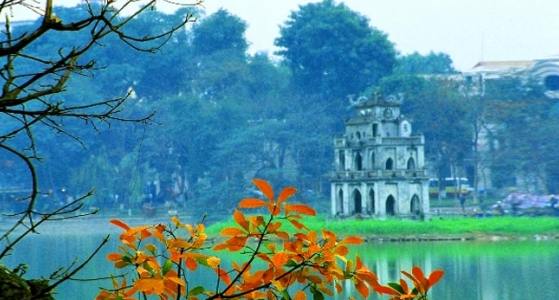
One city, two sides, yin and yang—an ancient culture and modern influence, tranquility and chaos, tradition and innovation. The capital of Vietnam maintains a captivating balance between retaining the original charm of its rich history and culture and adapting it to contemporary values from around the world. The face of Hanoi includes the villas of the former French colonial period, the iconic old condominiums, tree-lined boulevards, a world of cafes, some great north Vietnamese cuisine, and its unforgettable, noisy, colorful street life.
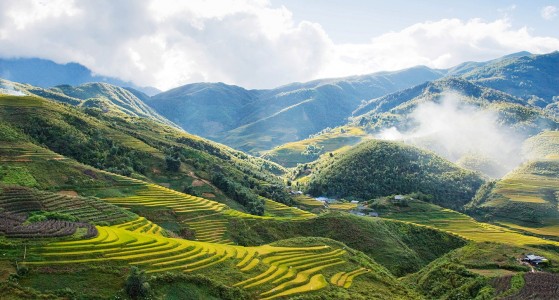
Trekking is a must when visiting Sapa. This former French hill station, established in the late 1880s, has a network of trails to trek, suitable for all levels, from easy to more challenging routes. Hike through ethnic minority villages, pass terraced rice fields and rolling mountains, and get a glimpse into the local cultures nestled within Sapa’s stunning natural beauty.
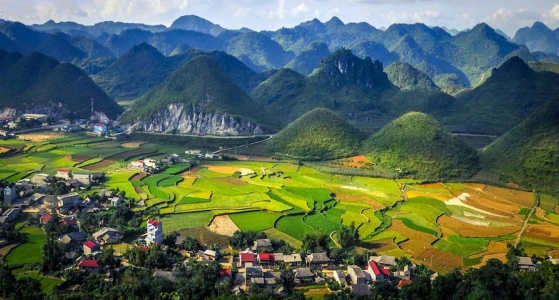
The several-day loop by motorbike through the Ha Giang highlands in northern Vietnam is not for the faint-hearted, to quote the New York Times. Its narrow, sharply twisting paths and roads zig-zagging across ultra-steep mountain passes may be a bit daunting for some people. If this is your first visit to this region, it is highly recommended that you travel with an experienced guide or motorcycle rider.
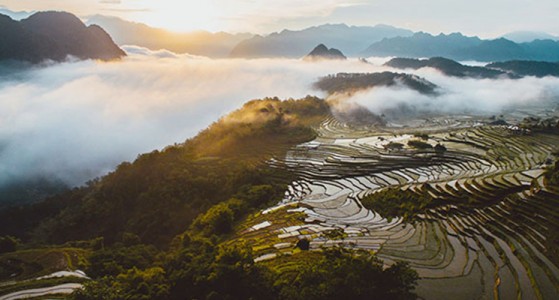
Pu Luong is a hidden paradise in northern Vietnam, great for hiking. It has cute homestays and a world close to nature. It is a picture of stunning rice field terraces against a backdrop of mountains, with small villages of the Thai ethnic minority dotted along the valley floor. This is a world of nature, from the irrigation waterwheels and forests to farmers working in their fields and water buffalo grazing close by.
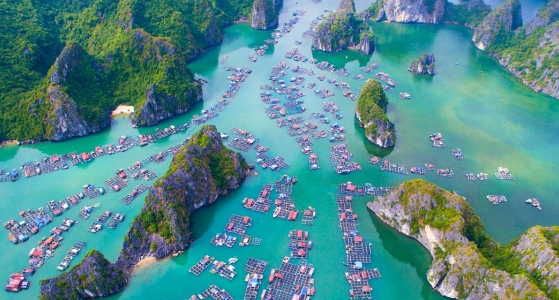
If you are staying in Hanoi, there is undoubtedly no better way to escape the city’s bustling life than by cruising Halong Bay overnight. This UNESCO World Heritage Site is famed for its stunning limestone karsts that rise dramatically from the bay’s deep blue waters. Watch the sun set from the cruise ship’s deck and fall asleep to the gentle sound of waves lapping against the boat.
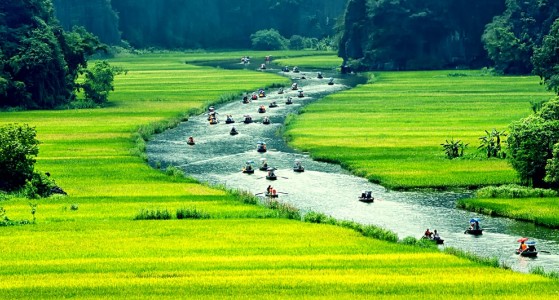
Often referred to as “Halong Bay on land," Ninh Binh’s landscape is famed for its jagged limestone peaks rising from flat rice paddies and its mellow streams meandering through this incredible landscape. Sampan boats, rowed by the local people, lead you on a journey through this karst scenery, floating through tunnels and caves, surrounded by colossal limestone outcrops. It is also well worth climbing the 500 steps up Hang Mua Peak for a spectacular bird's-eye view of the area.
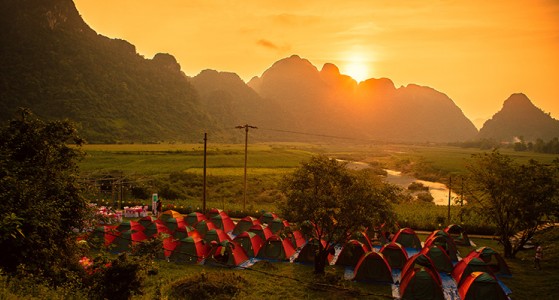
Quang Binh was firmly stamped on the world tourism map with the discovery of the awe-inspiring Phong Nha and Son Doong caves. Since then, the province has become known as the Kingdom of Caves and has attracted speleologists, cavers, explorers, and travelers. Besides this magnificent cave system, Quang Binh also has other attractions, such as its system of rivers and lakes, beaches, and outdoor activities.
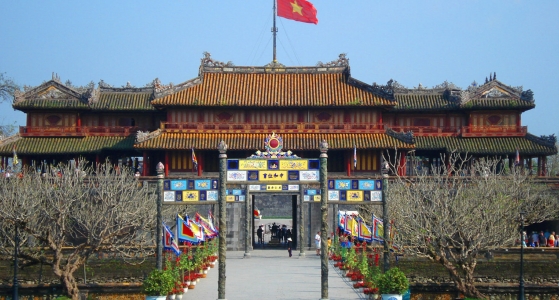
Hue, located in Central Vietnam, is best known for its royal mausoleums, the former imperial citadel, and iconic pagodas. Boasting a fantastic and rich cuisine, the city is not only a favorite destination for those who love architecture, but it is also a mecca for those on a gastronomic tour. For history buffs, the region still has several places with remnants from the Vietnam War, such as a military base and tunnels in the DMZ.
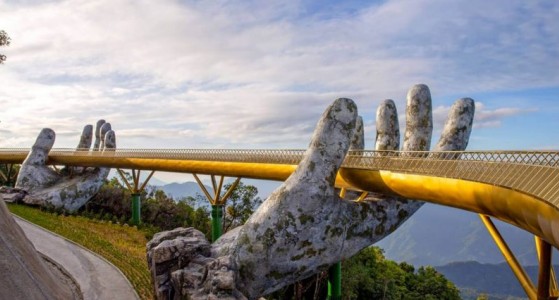
Da Nang is the busiest tourist city in central Vietnam, and it is used as a springboard for visiting three worldwide famous heritage sites: the Hue Imperial Capital, My Son Sanctuary, and Hoi An ancient town. It is also famed for its powdery white sands and crystal-clear seas, making it an ideal beach resort holiday.
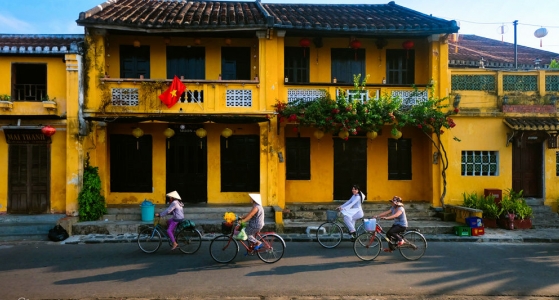
Hoi An, awash with its famous bright yellow ochre facades, has retained a wealth of cultural and historical attractions. Meander the narrow alleyways of the ancient town, where medieval two-story wooden buildings seem frozen in time. See Hoi An at night, brimming with a myriad of colorful lanterns, visit the old congregation halls of the town’s former Chinese community, sample a huge variety of cuisine, hire a bike, and cycle down the alleys and lanes and further afield to explore the surrounding countryside.
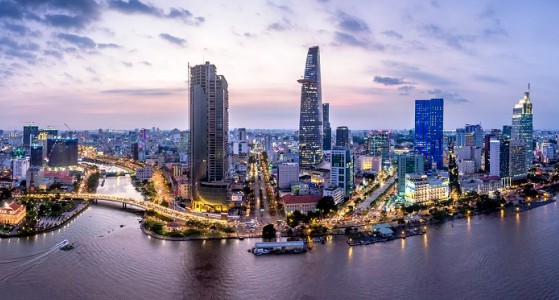
Cosmopolitan Ho Chi Minh City is Hanoi’s southern counterpart. It is Vietnam’s largest city and the country’s business and financial center. Visit the War Remnants Museum and the Reunification Palace, sip coffee at one of the many picturesque coffee shops, and party the night away at some of Vietnam’s best rooftops.
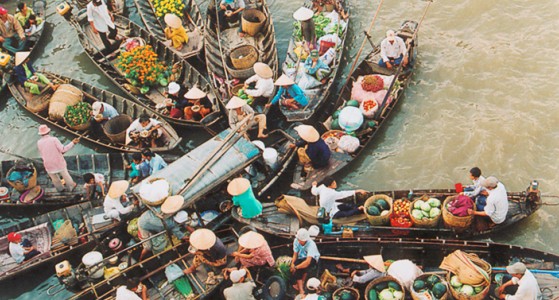
The Mekong Delta neighbors Ho Chi Minh City, making it close enough to visit on a day tour. Explore the waterways, mangrove forests, and lush green rice fields where life is governed by the ebb and flow of southeast Asia’s most iconic river, the Mekong River. For an immersive experience, we recommend spending one or two nights in one of the riverside towns or taking a longer trip to travel by boat down the Mekong into Cambodia.
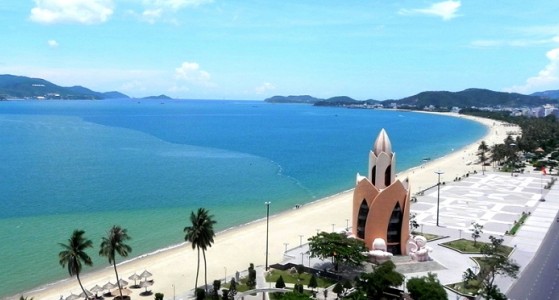
Sun-kissed relaxation is part of everyday life in the bustling coastal town of Nha Trang. After all, this area has more days of sunshine per year than anywhere else in Vietnam. Go island-hopping, diving, swimming, or just relax and enjoy the beautiful view of the sunset. Nha Trang’s surrounding countryside is also great for exploring by bicycle or motorbike.
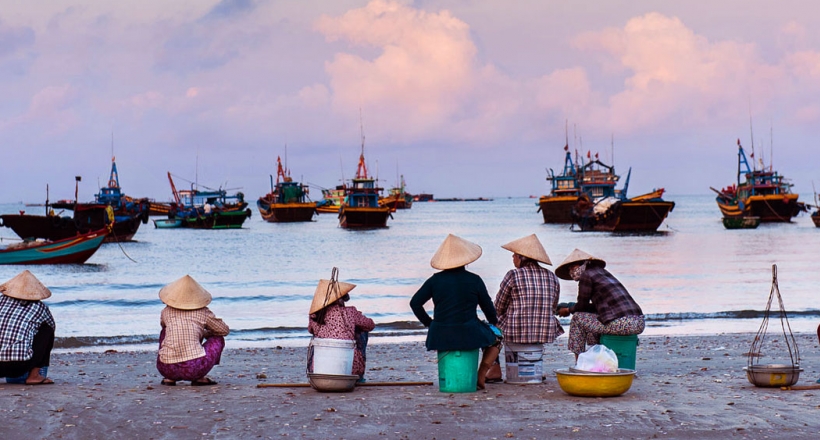
Set in a coastal desert, Mui Ne is known for its red and white sand dunes. It also offers perfect conditions for kiteboarding and windsurfing, which draw large watersport-loving crowds. Mui Ne is alluring to anyone seeking their own little slice of paradise on palm tree-lined beaches close to delicious restaurants, lively bars, and relaxing spas.
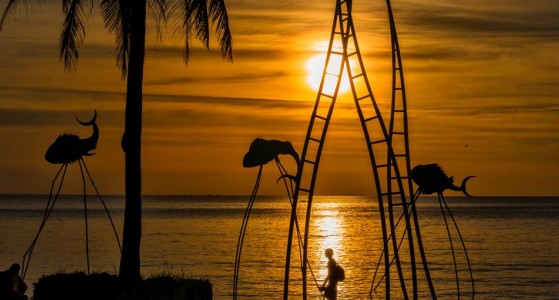
Lapping jewel-blue waters edged by fine sandy beaches, Phu Quoc Island is a place to enjoy the sun, surrounded by a breathtaking natural environment. This is Vietnam’s largest island (the size of Phuket in Thailand) and is a scuba diving and snorkeling paradise. Incidentally, Phu Quoc is Vietnam’s only locality offering 30-day visa-free entry.

One city, two sides, yin and yang—an ancient culture and modern influence, tranquility and chaos, tradition and innovation. The capital of Vietnam maintains a captivating balance between retaining the original charm of its rich history and culture and adapting it to contemporary values from around the world. The face of Hanoi includes the villas of the former French colonial period, the iconic old condominiums, tree-lined boulevards, a world of cafes, some great north Vietnamese cuisine, and its unforgettable, noisy, colorful street life.

Trekking is a must when visiting Sapa. This former French hill station, established in the late 1880s, has a network of trails to trek, suitable for all levels, from easy to more challenging routes. Hike through ethnic minority villages, pass terraced rice fields and rolling mountains, and get a glimpse into the local cultures nestled within Sapa’s stunning natural beauty.

The several-day loop by motorbike through the Ha Giang highlands in northern Vietnam is not for the faint-hearted, to quote the New York Times. Its narrow, sharply twisting paths and roads zig-zagging across ultra-steep mountain passes may be a bit daunting for some people. If this is your first visit to this region, it is highly recommended that you travel with an experienced guide or motorcycle rider.

Pu Luong is a hidden paradise in northern Vietnam, great for hiking. It has cute homestays and a world close to nature. It is a picture of stunning rice field terraces against a backdrop of mountains, with small villages of the Thai ethnic minority dotted along the valley floor. This is a world of nature, from the irrigation waterwheels and forests to farmers working in their fields and water buffalo grazing close by.

If you are staying in Hanoi, there is undoubtedly no better way to escape the city’s bustling life than by cruising Halong Bay overnight. This UNESCO World Heritage Site is famed for its stunning limestone karsts that rise dramatically from the bay’s deep blue waters. Watch the sun set from the cruise ship’s deck and fall asleep to the gentle sound of waves lapping against the boat.

Often referred to as “Halong Bay on land," Ninh Binh’s landscape is famed for its jagged limestone peaks rising from flat rice paddies and its mellow streams meandering through this incredible landscape. Sampan boats, rowed by the local people, lead you on a journey through this karst scenery, floating through tunnels and caves, surrounded by colossal limestone outcrops. It is also well worth climbing the 500 steps up Hang Mua Peak for a spectacular bird's-eye view of the area.

Quang Binh was firmly stamped on the world tourism map with the discovery of the awe-inspiring Phong Nha and Son Doong caves. Since then, the province has become known as the Kingdom of Caves and has attracted speleologists, cavers, explorers, and travelers. Besides this magnificent cave system, Quang Binh also has other attractions, such as its system of rivers and lakes, beaches, and outdoor activities.

Hue, located in Central Vietnam, is best known for its royal mausoleums, the former imperial citadel, and iconic pagodas. Boasting a fantastic and rich cuisine, the city is not only a favorite destination for those who love architecture, but it is also a mecca for those on a gastronomic tour. For history buffs, the region still has several places with remnants from the Vietnam War, such as a military base and tunnels in the DMZ.

Da Nang is the busiest tourist city in central Vietnam, and it is used as a springboard for visiting three worldwide famous heritage sites: the Hue Imperial Capital, My Son Sanctuary, and Hoi An ancient town. It is also famed for its powdery white sands and crystal-clear seas, making it an ideal beach resort holiday.

Hoi An, awash with its famous bright yellow ochre facades, has retained a wealth of cultural and historical attractions. Meander the narrow alleyways of the ancient town, where medieval two-story wooden buildings seem frozen in time. See Hoi An at night, brimming with a myriad of colorful lanterns, visit the old congregation halls of the town’s former Chinese community, sample a huge variety of cuisine, hire a bike, and cycle down the alleys and lanes and further afield to explore the surrounding countryside.

Cosmopolitan Ho Chi Minh City is Hanoi’s southern counterpart. It is Vietnam’s largest city and the country’s business and financial center. Visit the War Remnants Museum and the Reunification Palace, sip coffee at one of the many picturesque coffee shops, and party the night away at some of Vietnam’s best rooftops.

The Mekong Delta neighbors Ho Chi Minh City, making it close enough to visit on a day tour. Explore the waterways, mangrove forests, and lush green rice fields where life is governed by the ebb and flow of southeast Asia’s most iconic river, the Mekong River. For an immersive experience, we recommend spending one or two nights in one of the riverside towns or taking a longer trip to travel by boat down the Mekong into Cambodia.

Sun-kissed relaxation is part of everyday life in the bustling coastal town of Nha Trang. After all, this area has more days of sunshine per year than anywhere else in Vietnam. Go island-hopping, diving, swimming, or just relax and enjoy the beautiful view of the sunset. Nha Trang’s surrounding countryside is also great for exploring by bicycle or motorbike.

Set in a coastal desert, Mui Ne is known for its red and white sand dunes. It also offers perfect conditions for kiteboarding and windsurfing, which draw large watersport-loving crowds. Mui Ne is alluring to anyone seeking their own little slice of paradise on palm tree-lined beaches close to delicious restaurants, lively bars, and relaxing spas.

Lapping jewel-blue waters edged by fine sandy beaches, Phu Quoc Island is a place to enjoy the sun, surrounded by a breathtaking natural environment. This is Vietnam’s largest island (the size of Phuket in Thailand) and is a scuba diving and snorkeling paradise. Incidentally, Phu Quoc is Vietnam’s only locality offering 30-day visa-free entry.

Customize Vietnam


Adventure Travel Trade Association


American Society of Travel Agents

Family Travel Association


TripAdvisor


Wikipedia

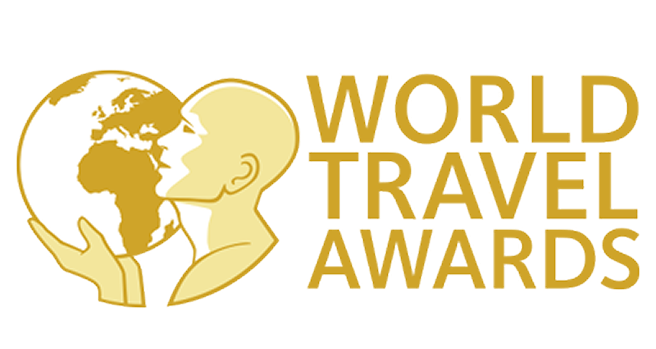
World Travel Awards
With over 15 years of experience in the tourism field, Southeast Asia Travel company has built a solid reputation as experts in designing custom tours across Southeast Asia: Vietnam, Laos, Cambodia, Thailand, Singapore, Malaysia, Indonesia, Myanmar, Philippines... Read more
